Additive Manufacturing of Metal Materials for Construction Engineering: An Overview on Technologies and Applications
Abstract
:1. Introduction
2. Metal Additive Manufacturing Technologies
2.1. Materials
- -
- The mechanical strength, as yield stress, ductility, wear, and fatigue resistance are key properties in determining whether the metal can withstand the expected stresses.
- -
- The density of the material, which affects the weight of the finished component and can be a critical factor in many applications.
- -
- Thermal and electrical conductivity, important properties for electronic and thermal applications.
- -
- Corrosion resistance, since if the component will be exposed to corrosive environments, a resistant metal must be chosen.
- -
- The microstructure of the 3D-printed metal, considering its features, imperfections, and defects, which can influence the properties of the finished part.
- -
- Biocompatibility, since, for example, for medical applications, the material must be biocompatible and nontoxic.
2.2. Overview Remarks
2.3. Features of 3D Printing Methods
3. Printing Process Parameters for Metal AM
3.1. Laser-Related Parameters
3.2. Scan-Related Parameters
3.3. Powder-Related Parameters
3.4. Temperature-Related Parameters
3.5. Printing Directions and Orientations
3.6. Effects of Process Parameters on the Properties of 3D-Printed Metals
4. Metal Additive Manufacturing in Construction
4.1. Optimized Structural Node by Arup
4.2. MX3D Pedestrian Bridge
4.3. Takenaka Connector
4.4. AM Steel Reinforcement for Concrete
4.5. Joining Aluminium Profiles
4.6. Future Applications
5. The Potentials of Metal AM in Topological Optimization
5.1. Nonconventional Geometries
5.1.1. Topology Optimization
- -
- Size optimisation, which considers the variation in size of the elements. In order to find the optimal solution (weight, stress, etc.), the cross-sectional areas of the beams, etc., are adjusted (Figure 25a).
- -
- Shape optimisation, which concerns the changing of the structural form. It allows one to remodel holes in the model, but not to eliminate them (Figure 25b).
- -
- Topological optimisation, which is the general form of structural optimisation. It allows specific parts to be added or removed in the design domain (Figure 25c).
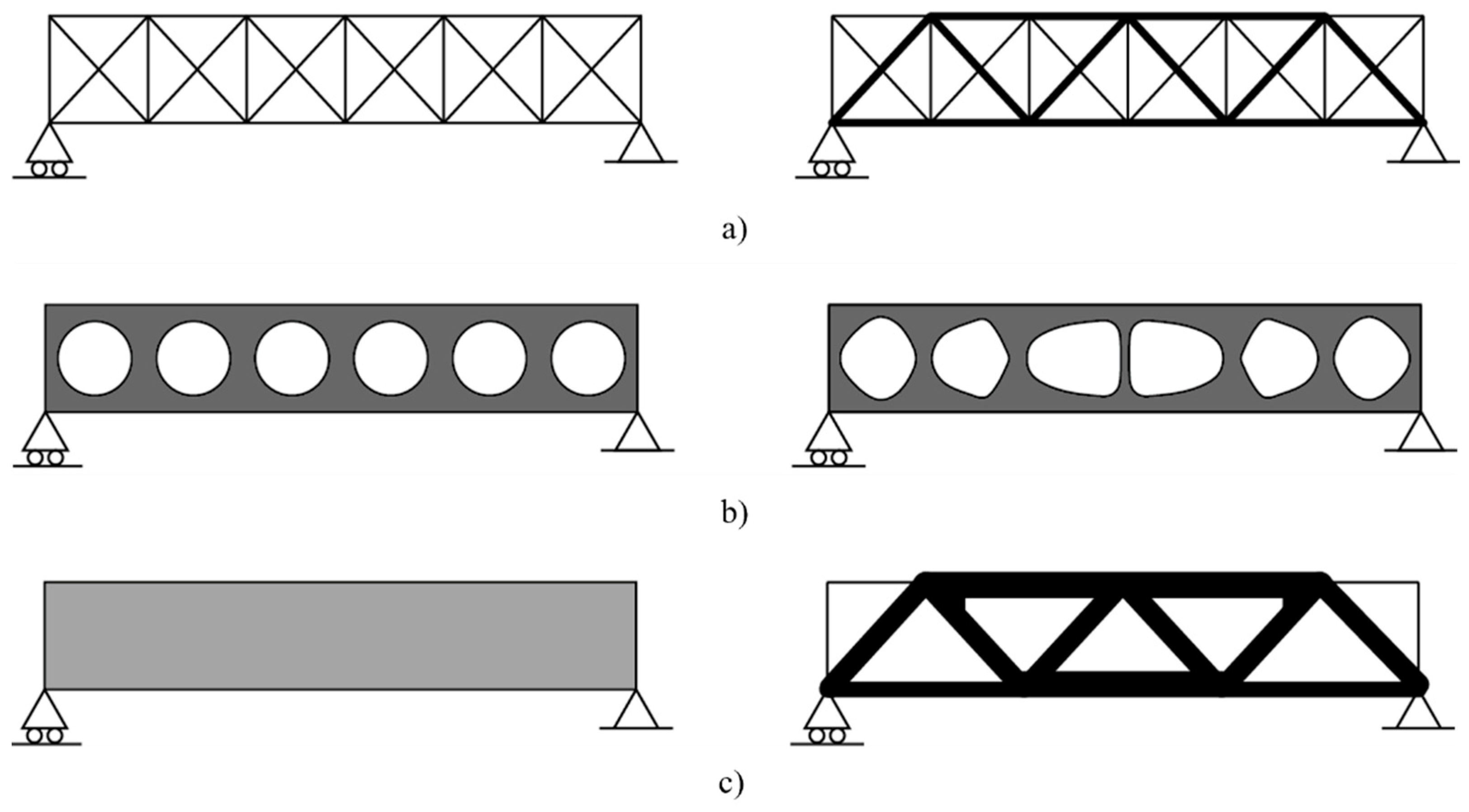
- -
- Minimise/maximise f(x,y).
- -
- Behaviour constraints on y.
- -
- Design constraints on x.
- -
- Equilibrium constraints.
- -
- f is the objective function of the optimisation problem, i.e., the target of the process; typically, it represents the parameter subject to constraints in the design domain.
- -
- x represents the design variables, which describe the geometry and material. Constraints can also be set as geometric restrictions on parts of the domain to be constrained or on dimensions.
- -
- y represents the state variables, which describe the structural response. They can be expressed in terms of stresses, displacements or forces.
- SIMP method
- -
- Eh is the Young’s modulus of the optimized element.
- -
- ρ is the pseudo-density.
- -
- p is the penalization factor (p > 1).
- -
- E0 is the initial Young’s modulus.
- Level-Set method
- The application of topological optimization
- -
- Stress-constrained optimisation (SCO). According to this approach, the goal is to minimise the structural weight for a stress constraint. In this case, stresses are required to be less than the elastic limit of the material (Inconel 718) divided by a factor of safety.
- -
- Continuous compliance optimisation (CCO). In most optimisation problems, the structural compliance parameter (to be understood as the inverse of stiffness) is used as the objective function to be minimised. Usually, in this formulation, the constraint is represented by an arbitrary value on the volume of the material.
- -
- Discrete compliance optimisation (DCO). The terms of the optimisation problem follow those of the CCO approach. However, it considers discrete variables that return the problem to a binary solution: 1 (solid), 0 (void).
5.1.2. Lightweight Components
- -
- Bending-dominated structures: The design elements are mainly subject to bending moment. Therefore, these structures exhibit compliant behaviour.
- -
- Stretch-dominated structures: The structures are mainly subject to axial loads. Generally, this type is stronger and stiffer than the previous one.
- -
- Solid: This strategy shows a topologically optimised result using the SIMP method (Figure 29a).
- -
- Intersected lattice: According to this strategy, the solution is obtained by intersecting a topologically optimised discrete solid/vacuum result with a uniform lattice structure consisting of unit cells with constant volume fraction (Figure 29b).
- -
- Graded lattice: The greyscale TO solution is the basis for mapping a lattice with variable volume fraction (Figure 29c).
- -
- Scaled lattice: The rescaled greyscale TO solution is the basis for mapping a lattice with variable volume fraction (Figure 29d).
- -
- Uniform lattice: The design domain is filled with a uniform lattice (Figure 29e).
5.2. Use of AM in Repair of Existing Structures
- Preparation stage. In the first step, considerations concern the cost-effectiveness of the repair/reinforcement of the degraded component. Next, a geometric check is performed between the worn elements and the nominal model. This comparison generates an error map, which highlights the errors between the two models. Finally, the repair area can be identified and judgements made on the extent of the damage.
- Production stage. In this stage, the previously identified area is repaired/reinforced through AM or hybrid manufacturing processes.
- Post-repair stage. In the final step, a geometric inspection is performed to verify the correct execution. In addition, the restored element can be mechanically characterised by means of material strength tests.
6. Conclusions
Author Contributions
Funding
Data Availability Statement
Conflicts of Interest
References
- Xiang, H.; Zhou, Y.; Zhang, X.; Li, J.; Huang, Y.; Mou, G.; Wu, C. Supportfree Printing in Laser Powder Bed Fusion: Formation Mechanisms of Discontinuity, Dross and Surface Roughness. Opt. Laser Technol. 2024, 177, 111201. [Google Scholar] [CrossRef]
- Housholder, R.F. Molding Process. U.S. Patent 4247508, 27 January 1981. [Google Scholar]
- Wong, K.V.; Hernandez, A. A Review of Additive Manufacturing. ISRN Mech. Eng. 2012, 2012, 208760. [Google Scholar] [CrossRef]
- Chen, L.-Y.; Qin, P.; Zhang, L.; Zhang, L.-C. An Overview of Additively Manufactured Metal Matrix Composites: Preparation, Performance, and Challenge. Int. J. Extrem. Manuf. 2024, 6, 052006. [Google Scholar] [CrossRef]
- Coon, C.; Pretzel, B.; Lomax, T.; Strlič, M. Preserving Rapid Prototypes: A Review. Herit. Sci. 2016, 4, 40. [Google Scholar] [CrossRef]
- Abdulhameed, O.; Al-Ahmari, A.; Ameen, W.; Mian, S.H. Additive Manufacturing: Challenges, Trends, and Applications. Adv. Mech. Eng. 2019, 11, 1–27. [Google Scholar] [CrossRef]
- Singh, R.; Gupta, A.; Tripathi, O.; Srivastava, S.; Singh, B.; Awasthi, A.; Rajput, S.K.; Sonia, P.; Singhal, P.; Saxena, K.K. Powder Bed Fusion Process in Additive Manufacturing: An Overview. Mater. Today Proc. 2019, 26, 3058–3070. [Google Scholar] [CrossRef]
- Ligon, S.C.; Liska, R.; Stampfl, J.; Gurr, M.; Mülhaupt, R. Polymers for 3D Printing and Customized Additive Manufacturing. Chem. Rev. 2017, 117, 10212–10290. [Google Scholar] [CrossRef]
- Herzog, D.; Seyda, V.; Wycisk, E.; Emmelmann, C. Additive Manufacturing of Metals. Acta Mater. 2016, 117, 371–392. [Google Scholar] [CrossRef]
- Bhatia, A.; Sehgal, A.K. Additive Manufacturing Materials, Methods and Applications: A Review. Mater. Today Proc. 2021, 81, 1060–1067. [Google Scholar] [CrossRef]
- Pratheesh Kumar, S.; Elangovan, S.; Mohanraj, R.; Ramakrishna, J.R. Review on the Evolution and Technology of State-of-the-Art Metal Additive Manufacturing Processes. Mater. Today Proc. 2021, 46, 7907–7920. [Google Scholar] [CrossRef]
- Wang, Y.; Zhou, Y.; Lin, L.; Corker, J.; Fan, M. Overview of 3D Additive Manufacturing (AM) and Corresponding AM Composites. Compos. Part A Appl. Sci. Manuf. 2020, 139, 106114. [Google Scholar] [CrossRef]
- Fijoł, N.; Aguilar-Sánchez, A.; Mathew, A.P. 3D-Printable Biopolymer-Based Materials for Water Treatment: A Review. Chem. Eng. J. 2022, 430, 132964. [Google Scholar] [CrossRef]
- Jiang, J.; Xu, X.; Stringer, J. Support Structures for Additive Manufacturing: A Review. J. Manuf. Mater. Process. 2018, 2, 64. [Google Scholar] [CrossRef]
- Karar, G.C.; Kumar, R.; Chattopadhyaya, S. An Analysis on the Advanced Research in Additive Manufacturing. In Advances in Production and Industrial Engineering. Part of the Lecture Notes in Mechanical Engineering Book Series; Springer: Singapore, 2021; pp. 229–277. ISBN 9789811555183. [Google Scholar]
- ISO/ASTM 52900; Additive Manufacturing—General Principles—Terminology. ASTM—American Society for Testing and Materials: West Conshohocken, PA, USA, 2015.
- Durai Murugan, P.; Vijayananth, S.; Natarajan, M.P.; Jayabalakrishnan, D.; Arul, K.; Jayaseelan, V.; Elanchezhian, J. A Current State of Metal Additive Manufacturing Methods: A Review. Mater. Today Proc. 2021, 59, 1277–1283. [Google Scholar] [CrossRef]
- Shrinivas Mahale, R.; Shamanth, V.; Hemanth, K.; Nithin, S.K.; Sharath, P.C.; Shashanka, R.; Patil, A.; Shetty, D. Processes and Applications of Metal Additive Manufacturing. Mater. Today Proc. 2021, 54, 228–233. [Google Scholar] [CrossRef]
- Badoniya, P.; Srivastava, M.; Jain, P.K.; Rathee, S. A State-of-the-Art Review on Metal Additive Manufacturing: Milestones, Trends, Challenges and Perspectives; Springer: Berlin/Heidelberg, Germany, 2024; Volume 46, ISBN 0123456789. [Google Scholar]
- Lee, J.Y.; An, J.; Chua, C.K. Fundamentals and Applications of 3D Printing for Novel Materials. Appl. Mater. Today 2017, 7, 120–133. [Google Scholar] [CrossRef]
- Ngo, T.D.; Kashani, A.; Imbalzano, G.; Nguyen, K.T.Q.; Hui, D. Additive Manufacturing (3D Printing): A Review of Materials, Methods, Applications and Challenges. Compos. Part B Eng. 2018, 143, 172–196. [Google Scholar] [CrossRef]
- Wang, J.C.; Dommati, H.; Hsieh, S.J. Review of Additive Manufacturing Methods for High-Performance Ceramic Materials. Int. J. Adv. Manuf. Technol. 2019, 103, 2627–2647. [Google Scholar] [CrossRef]
- Wang, Y.; Chen, R.; Liu, Y. A Double Mask Projection Exposure Method for Stereolithography. Sens. Actuators A Phys. 2020, 314, 112228. [Google Scholar] [CrossRef]
- Mazzoli, A. Selective Laser Sintering in Biomedical Engineering. Med. Biol. Eng. Comput. 2013, 51, 245–256. [Google Scholar] [CrossRef]
- Redwood, B.; Schoffer, F.; Garret, B. The 3D Printing Handbook. Technologies, Design and Applications; 3D Hubs B.V.: Amsterdam, The Netherlands, 2020. [Google Scholar]
- Giri, J.; Sunheriya, N.; Sathish, T.; Kadu, Y.; Chadge, R.; Giri, P.; Parthiban, A.; Mahatme, C. Optimization of Process Parameters to Improve Mechanical Properties of Fused Deposition Method Using Taguchi Method. Interactions 2024, 245, 87. [Google Scholar] [CrossRef]
- Alafaghani, A.; Qattawi, A.; Alrawi, B.; Guzman, A. Experimental Optimization of Fused Deposition Modelling Processing Parameters: A Design-for-Manufacturing Approach. Procedia Manuf. 2017, 10, 791–803. [Google Scholar] [CrossRef]
- Hafsa, M.N.; Kassim, N.; Ismail, S.; Kamaruddin, S.A.; Hafeez, T.M.; Ibrahim, M.; Samsudin, Z.H. Study on Surface Roughness Quality of FDM and MJM Additive Manufacturing Model for Implementation as Investment Casting Sacrificial Pattern. J. Mech. Eng. 2018, 5, 25–34. [Google Scholar]
- Emiliani, N.; Porcaro, R.; Pisaneschi, G.; Bortolani, B.; Ferretti, F.; Fontana, F.; Campana, G.; Fiorini, M.; Marcelli, E.; Cercenelli, L. Post-Printing Processing and Aging Effects on Polyjet Materials Intended for the Fabrication of Advanced Surgical Simulators. J. Mech. Behav. Biomed. Mater. 2024, 156, 106598. [Google Scholar] [CrossRef]
- Yang, Y.; Bharech, S.; Finger, N.; Zhou, X.; Schröder, J.; Xu, B.X. Elasto-Plastic Residual Stress Analysis of Selective Laser Sintered Porous Materials Based on 3D-Multilayer Thermo-Structural Phase-Field Simulations. npj Comput. Mater. 2024, 10, 117. [Google Scholar] [CrossRef]
- Rajesh, R.; Sudheer, S.; Kulkarni, M.V. Selective Laser Sintering Process—A Review. Int. J. Curr. Eng. Sci. Res. (IJCESR) 2015, 2, 91–100. [Google Scholar]
- Paolini, A.; Kollmannsberger, S.; Rank, E. Additive Manufacturing in Construction: A Review on Processes, Applications, and Digital Planning Methods. Addit. Manuf. 2019, 30, 100894. [Google Scholar] [CrossRef]
- Volpe, S.; Sangiorgio, V.; Fiorito, F.; Varum, H. Overview of 3D Construction Printing and Future Perspectives: A Review of Technology, Companies and Research Progression. Archit. Sci. Rev. 2022, 67, 1–22. [Google Scholar] [CrossRef]
- Placzek, G.; Schwerdtner, P. Concrete Additive Manufacturing in Construction: Integration Based on Component-Related Fabrication Strategies. Buildings 2023, 13, 1769. [Google Scholar] [CrossRef]
- Pacillo, G.A.; Ranocchiai, G.; Loccarini, F.; Fagone, M. Additive Manufacturing in Construction: A Review on Technologies, Processes, Materials, and Their Applications of 3D and 4D Printing. Mater. Des. Process. Commun. 2021, 3, e253. [Google Scholar] [CrossRef]
- Scheel, P.; Wrobel, R.; Rheingans, B.; Mayer, T.; Leinenbach, C.; Mazza, E.; Hosseini, E. Advancing Efficiency and Reliability in Thermal Analysis of Laser Powder-Bed Fusion. Int. J. Mech. Sci. 2023, 260, 108583. [Google Scholar] [CrossRef]
- Yap, C.Y.; Chua, C.K.; Dong, Z.L.; Liu, Z.H.; Zhang, D.Q.; Loh, L.E.; Sing, S.L. Review of Selective Laser Melting: Materials and Applications. Appl. Phys. Rev. 2015, 2, 041101. [Google Scholar] [CrossRef]
- Song, B.; Zhao, X.; Li, S.; Han, C.; Wei, Q.; Wen, S.; Liu, J.; Shi, Y. Differences in Microstructure and Properties between Selective Laser Melting and Traditional Manufacturing for Fabrication of Metal Parts: A Review. Front. Mech. Eng. 2015, 10, 111–125. [Google Scholar] [CrossRef]
- Du, X.; Chen, J.; She, Y.; Liu, Y.; Yang, Y.; Yang, J.; Dong, S. Effect of Process Parameter Optimization on Morphology and Mechanical Properties of Ti6Al4V Alloy Produced by Selective Laser Melting. Prog. Nat. Sci. Mater. Int. 2023, 33, 911–917. [Google Scholar] [CrossRef]
- Fette, M.; Sander, P.; Wulfsberg, J.; Zierk, H.; Herrmann, A.; Stoess, N. Optimized and Cost-Efficient Compression Molds Manufactured by Selective Laser Melting for the Production of Thermoset Fiber Reinforced Plastic Aircraft Components. Procedia CIRP 2015, 35, 25–30. [Google Scholar] [CrossRef]
- Liu, B.; Bai, P.; Li, Y. Post Treatment Process and Selective Laser Sintering Mechanism of Polymer-Coated Mo Powder. Open Mater. Sci. J. 2011, 5, 194–198. [Google Scholar] [CrossRef]
- Andreacola, F.R.; Capasso, I.; Pilotti, L.; Brando, G. Influence of 3D-Printing Parameters on the Mechanical Properties of 17-4PH Stainless Steel Produced through Selective Laser Melting. Frat. Intregrità Strutt. 2021, 58, 282–295. [Google Scholar] [CrossRef]
- Andreacola, F.R.; Capasso, I.; Langella, A.; Brando, G. 3D-Printed Metals: Process Parameters Effects on Mechanical Properties of 17-4PH Stainless Steel. Heliyon 2023, 9, e17698. [Google Scholar] [CrossRef]
- Gokuldoss, P.K.; Kolla, S.; Eckert, J. Additive Manufacturing Processes: Selective Laser Melting, Electron Beam Melting and Binder Jetting-Selection Guidelines. Materials 2017, 10, 672. [Google Scholar] [CrossRef]
- Murr, L.E.; Gaytan, S.M.; Ramirez, D.A.; Martinez, E.; Hernandez, J.; Amato, K.N.; Shindo, P.W.; Medina, F.R.; Wicker, R.B. Metal Fabrication by Additive Manufacturing Using Laser and Electron Beam Melting Technologies. J. Mater. Sci. Technol. 2012, 28, 167–177. [Google Scholar] [CrossRef]
- Huang, N.; Cook, O.J.; Argüelles, A.P.; Beese, A.M. Review of Process–Structure–Property Relationships in Metals Fabricated Using Binder Jet Additive Manufacturing. Metallogr. Microstruct. Anal. 2023, 12, 883–905. [Google Scholar] [CrossRef]
- Tischel, F.; Reineke, L.; Alrashdan, J.; Ploshikhin, V. Experimental Investigation and Modeling of Densification during Sintering of Binder Jetted Ti–6Al–4V. Powder Technol. 2024, 444, 119958. [Google Scholar] [CrossRef]
- Aramian, A.; Razavi, S.M.J.; Sadeghian, Z.; Berto, F. A Review of Additive Manufacturing of Cermets. Addit. Manuf. 2020, 33, 101130. [Google Scholar] [CrossRef]
- Mostafaei, A.; Elliott, A.M.; Barnes, J.E.; Li, F.; Tan, W.; Cramer, C.L.; Nandwana, P.; Chmielus, M. Binder Jet 3D Printing-Process Parameters, Materials, Properties, Modeling, and Challenges. Prog. Mater. Sci. 2021, 119, 100707. [Google Scholar] [CrossRef]
- Blunk, H.; Seibel, A. Design Guidelines for Metal Binder Jetting. Prog. Addit. Manuf. 2024, 9, 725–732. [Google Scholar] [CrossRef]
- Dwivedi, S.; Dixit, A.R.; Das, A.K.; Nag, A. A Novel Additive Texturing of Stainless Steel 316L Through Binder Jetting Additive Manufacturing. Int. J. Precis. Eng. Manuf. Green Technol. 2023, 10, 1605–1613. [Google Scholar] [CrossRef]
- Mueller, B.; Kochan, D. Laminated Object Manufacturing for Rapid Tooling and Patternmaking in Foundry Industry. Comput. Ind. 1999, 39, 47–53. [Google Scholar] [CrossRef]
- Kan, C.; Zhao, L.; Cao, Y.; Ma, C.; Peng, Y.; Tian, Z. Microstructure Evolution and Strengthening Behavior of Maraging Steel Fabricated by Wire Arc Additive Manufacturing at Different Heat Treatment Processes. Mater. Sci. Eng. A 2024, 909, 146804. [Google Scholar] [CrossRef]
- Srivastava, M.; Rathee, S.; Tiwari, A.; Dongre, M. Wire Arc Additive Manufacturing of Metals: A Review on Processes, Materials and Their Behaviour. Mater. Chem. Phys. 2023, 294, 126988. [Google Scholar] [CrossRef]
- Ahmed, N. Direct Metal Fabrication in Rapid Prototyping: A Review. J. Manuf. Process. 2019, 42, 167–191. [Google Scholar] [CrossRef]
- Alami, A.H.; Ghani Olabi, A.; Alashkar, A.; Alasad, S.; Aljaghoub, H.; Rezk, H.; Abdelkareem, M.A. Additive Manufacturing in the Aerospace and Automotive Industries: Recent Trends and Role in Achieving Sustainable Development Goals. Ain Shams Eng. J. 2023, 14, 102516. [Google Scholar] [CrossRef]
- Arrizubieta, J.I.; Martínez, S.; Lamikiz, A.; Ukar, E.; Arntz, K.; Klocke, F. Instantaneous Powder Flux Regulation System for Laser Metal Deposition. J. Manuf. Process. 2017, 29, 242–251. [Google Scholar] [CrossRef]
- Pirch, N.; Linnenbrink, S.; Gasser, A.; Schleifenbaum, H. Laser-Aided Directed Energy Deposition of Metal Powder along Edges. Int. J. Heat Mass Transf. 2019, 143, 118464. [Google Scholar] [CrossRef]
- Yilmaz, O.; Ugla, A.A. Shaped Metal Deposition Technique in Additive Manufacturing: A Review. Proc. Inst. Mech. Eng. Part B J. Eng. Manuf. 2016, 230, 1781–1798. [Google Scholar] [CrossRef]
- Agelet de Saracibar, C.; Lundbäck, A.; Chiumenti, M.; Cervera, M. Shaped Metal Deposition Processes. In Encyclopedia of Thermal Stresses; Springer: Dordrecht, The Netherlands, 2014; pp. 4346–4355. [Google Scholar] [CrossRef]
- Cooke, S.; Ahmadi, K.; Willerth, S.; Herring, R. Metal Additive Manufacturing: Technology, Metallurgy and Modelling. J. Manuf. Process. 2020, 57, 978–1003. [Google Scholar] [CrossRef]
- Zhang, D.; Sun, S.; Qiu, D.; Gibson, M.A.; Dargusch, M.S.; Brandt, M.; Qian, M.; Easton, M. Metal Alloys for Fusion-Based Additive Manufacturing. Adv. Eng. Mater. 2018, 20, 1700952. [Google Scholar] [CrossRef]
- Li, Y.; Liang, X.; Yu, Y.; Wang, D.; Lin, F. Review on Additive Manufacturing of Single-Crystal Nickel-Based Superalloys. Chin. J. Mech. Eng. Addit. Manuf. Front. 2022, 1, 100019. [Google Scholar] [CrossRef]
- Mostafaei, A.; Ghiaasiaan, R.; Ho, I.T.; Strayer, S.; Chang, K.C.; Shamsaei, N.; Shao, S.; Paul, S.; Yeh, A.C.; Tin, S.; et al. Additive Manufacturing of Nickel-Based Superalloys: A State-of-the-Art Review on Process-Structure-Defect-Property Relationship. Prog. Mater. Sci. 2023, 136, 101108. [Google Scholar] [CrossRef]
- Mazzucato, F.; Forni, D.; Valente, A.; Cadoni, E. Laser Metal Deposition of Inconel 718 Alloy and As-Built Mechanical Properties Compared to Casting. Materials 2021, 14, 437. [Google Scholar] [CrossRef]
- Dixit, S.; Liu, S. Laser Additive Manufacturing of High-Strength Aluminum Alloys: Challenges and Strategies. J. Manuf. Mater. Process. 2022, 6, 156. [Google Scholar] [CrossRef]
- Rometsch, P.A.; Zhu, Y.; Wu, X.; Huang, A. Review of High-Strength Aluminium Alloys for Additive Manufacturing by Laser Powder Bed Fusion. Mater. Des. 2022, 219, 110779. [Google Scholar] [CrossRef]
- Farber, E.; Zhu, J.N.; Popovich, A.; Popovich, V. A Review of NiTi Shape Memory Alloy as a Smart Material Produced by Additive Manufacturing. Mater. Today Proc. 2019, 30, 761–767. [Google Scholar] [CrossRef]
- Felice, I.O.; Shen, J.; Barragan, A.F.C.; Moura, I.A.B.; Li, B.; Wang, B.; Khodaverdi, H.; Mohri, M.; Schell, N.; Ghafoori, E.; et al. Wire and Arc Additive Manufacturing of Fe-Based Shape Memory Alloys: Microstructure, Mechanical and Functional Behavior. Mater. Des. 2023, 231, 112004. [Google Scholar] [CrossRef]
- Wei, S.; Zhang, J.; Zhang, L.; Zhang, Y.; Song, B.; Wang, X.; Fan, J.; Liu, Q.; Shi, Y. Laser Powder Bed Fusion Additive Manufacturing of NiTi Shape Memory Alloys: A Review. Int. J. Extrem. Manuf. 2023, 5, 032001. [Google Scholar] [CrossRef]
- Ostovari Moghaddam, A.; Shaburova, N.A.; Samodurova, M.N.; Abdollahzadeh, A.; Trofimov, E.A. Additive Manufacturing of High Entropy Alloys: A Practical Review. J. Mater. Sci. Technol. 2021, 77, 131–162. [Google Scholar] [CrossRef]
- Ron, T.; Shirizly, A.; Aghion, E. Additive Manufacturing Technologies of High Entropy Alloys (HEA): Review and Prospects. Materials 2023, 16, 2454. [Google Scholar] [CrossRef]
- Cao, L.; Li, J.; Hu, J.; Liu, H.; Wu, Y.; Zhou, Q. Optimization of Surface Roughness and Dimensional Accuracy in LPBF Additive Manufacturing. Opt. Laser Technol. 2021, 142, 107246. [Google Scholar] [CrossRef]
- Nandhakumar, R.; Venkatesan, K. A Process Parameters Review on Selective Laser Melting-Based Additive Manufacturing of Single and Multi-Material: Microstructure, Physical Properties, Tribological, and Surface Roughness; Elsevier Ltd.: Amsterdam, The Netherlands, 2023; Volume 35, ISBN 5465151392629. [Google Scholar]
- Xia, C.; Pan, Z.; Polden, J.; Li, H.; Xu, Y.; Chen, S. Modelling and Prediction of Surface Roughness in Wire Arc Additive Manufacturing Using Machine Learning. J. Intell. Manuf. 2022, 33, 1467–1482. [Google Scholar] [CrossRef]
- Obilanade, D.; Dordlofva, C.; Törlind, P. Surface Roughness Considerations in Design for Additive Manufacturing—A Literature Review. Proc. Des. Soc. 2021, 1, 2841–2850. [Google Scholar] [CrossRef]
- Zai, L.; Zhang, C.; Wang, Y.; Guo, W.; Wellmann, D.; Tong, X.; Tian, Y. Laser Powder Bed Fusion of Precipitation-Hardened Martensitic Stainless Steels: A Review. Metals 2020, 10, 255. [Google Scholar] [CrossRef]
- Sefene, E.M. State-of-the-Art of Selective Laser Melting Process: A Comprehensive Review. J. Manuf. Syst. 2022, 63, 250–274. [Google Scholar] [CrossRef]
- Gardner, L.; Kyvelou, P.; Herbert, G.; Buchanan, C. Testing and Initial Verification of the World’s First Metal 3D Printed Bridge. J. Constr. Steel Res. 2020, 172, 106233. [Google Scholar] [CrossRef]
- Anant Pidge, P.; Kumar, H. Additive Manufacturing: A Review on 3 D Printing of Metals and Study of Residual Stress, Buckling Load Capacity of Strut Members. Mater. Today Proc. 2020, 21, 1689–1694. [Google Scholar] [CrossRef]
- Tan, J.H.; Wong, W.L.E.; Dalgarno, K.W. An Overview of Powder Granulometry on Feedstock and Part Performance in the Selective Laser Melting Process. Addit. Manuf. 2017, 18, 228–255. [Google Scholar] [CrossRef]
- Larimian, T.; Kannan, M.; Grzesiak, D.; AlMangour, B.; Borkar, T. Effect of Energy Density and Scanning Strategy on Densification, Microstructure and Mechanical Properties of 316L Stainless Steel Processed via Selective Laser Melting. Mater. Sci. Eng. A 2020, 770, 138455. [Google Scholar] [CrossRef]
- Chen, J.; Wang, X.; Pan, Y. Influence of Laser Power and Scan Speed on the Microstructure and Properties of GH4169 Alloy Prepared by Selective Laser Melting. IOP Conf. Series Mater. Sci. Eng. 2019, 688, 033064. [Google Scholar] [CrossRef]
- Bremen, S.; Meiners, W.; Diatlov, A. Selective Laser Melting: A Manufacturing Technology for the Future? Laser Tech J 2012, 9, 33–38. [Google Scholar] [CrossRef]
- Mercelis, P.; Kruth, J.P. Residual Stresses in Selective Laser Sintering and Selective Laser Melting. Rapid Prototyp. J 2006, 12, 254–265. [Google Scholar] [CrossRef]
- Zhang, W.; Tong, M.; Harrison, N.M. Scanning Strategies Effect on Temperature, Residual Stress and Deformation by Multi-Laser Beam Powder Bed Fusion Manufacturing. Addit. Manuf. 2020, 36, 101507. [Google Scholar] [CrossRef]
- Miao, X.; Liu, X.; Lu, P.; Han, J.; Duan, W.; Wu, M. Influence of Scanning Strategy on the Performances of GO-Reinforced Ti6Al4V Nanocomposites Manufactured by SLM. Metals 2020, 10, 1379. [Google Scholar] [CrossRef]
- Haferkamp, L.; Haudenschild, L.; Spierings, A.; Wegener, K.; Riener, K.; Ziegelmeier, S.; Leichtfried, G.J. The Influence of Particle Shape, Powder Flowability, and Powder Layer Density on Part Density in Laser Powder Bed Fusion. Metals 2021, 11, 418. [Google Scholar] [CrossRef]
- Spierings, A.B.; Herres, N.; Levy, G. Influence of the Particle Size Distribution on Surface Quality and Mechanical Properties in Additive Manufactured Stainless Steel Parts. Rapid Prototyp. J. 2010, 17, 195–202. [Google Scholar] [CrossRef]
- Huck-Jones, D.; Langley, C. Beyond Particle Size: Exploring the Influence of Particle Shape on Metal Powder Performance. Met. Addit. Manuf. 2017, 3, 99–103. [Google Scholar]
- Eddine, S.; Letenneur, M.; Alex, C.; Brailovski, V. Influence of Particle Morphology and Size Distribution on the Powder Flowability and Laser Powder Bed Fusion Manufacturability of Ti-6Al-4V Alloy. Addit. Manuf. 2020, 31, 100929. [Google Scholar] [CrossRef]
- Irrinki, H.; Dexter, M.; Barmore, B.; Enneti, R.; Pasebani, S.; Badwe, S.; Stitzel, J.; Malhotra, R.; Atre, S.V. Effects of Powder Attributes and Laser Powder Bed Fusion (L-PBF) Process Conditions on the Densification and Mechanical Properties of 17-4 PH Stainless Steel. JOM J. Miner. Met. Mater. Soc. 2016, 68, 860–868. [Google Scholar] [CrossRef]
- Rashid, R.; Masood, S.H.; Ruan, D.; Palanisamy, S.; Rahman Rashid, R.A.; Brandt, M. Effect of Scan Strategy on Density and Metallurgical Properties of 17-4PH Parts Printed by Selective Laser Melting (SLM). J. Mater. Process. Technol. 2017, 249, 502–511. [Google Scholar] [CrossRef]
- Nguyen, Q.B.; Luu, D.N.; Nai, S.M.L.; Zhu, Z.; Chen, Z.; Wei, J. The Role of Powder Layer Thickness on the Quality of SLM Printed Parts. Arch. Civ. Mech. Eng. 2018, 18, 948–955. [Google Scholar] [CrossRef]
- Haghdadi, N.; Laleh, M.; Moyle, M.; Primig, S. Additive Manufacturing of Steels: A Review of Achievements and Challenges. J. Mater. Sci. 2021, 56, 64–107. [Google Scholar] [CrossRef]
- Simonelli, M.; Tse, Y.Y.; Tuck, C. Effect of the Build Orientation on the Mechanical Properties and Fracture Modes of SLM Ti–6Al–4V. Mater. Sci. Eng. A 2014, 616, 1–11. [Google Scholar] [CrossRef]
- Guan, K.; Wang, Z.; Gao, M.; Li, X.; Zeng, X. Effects of Processing Parameters on Tensile Properties of Selective Laser Melted 304 Stainless Steel. Mater. Des. 2013, 50, 581–586. [Google Scholar] [CrossRef]
- How Does Part Orientation Affect a 3D Print? Practical Design Tips for Additive Manufacturing. 2024. Available online: https://www.hubs.com/knowledge-base/how-does-part-orientation-affect-3d-print/ (accessed on 7 June 2024).
- Yadollahi, A.; Shamsaei, N.; Thompson, S.M.; Elwany, A.; Bian, L. Effects of Building Orientation and Heat Treatment on Fatigue Behavior of Selective Laser Melted 17-4 PH Stainless Steel. Int. J. Fatigue 2017, 94, 218–235. [Google Scholar] [CrossRef]
- Hitzler, L.; Janousch, C.; Schanz, J.; Merkel, M.; Heine, B.; Mack, F.; Hall, W.; Öchsner, A. Direction and Location Dependency of Selective Laser Melted AlSi10Mg Specimens. J. Mater. Process. Technol. 2017, 243, 48–61. [Google Scholar] [CrossRef]
- Wang, C.G.; Zhu, J.X.; Wang, G.W.; Qin, Y.; Sun, M.Y.; Yang, J.L.; Shen, X.F.; Huang, S.K. Effect of Building Orientation and Heat Treatment on the Anisotropic Tensile Properties of AlSi10Mg Fabricated by Selective Laser Melting. J. Alloys Compd. 2022, 895, 162665. [Google Scholar] [CrossRef]
- Sufiiarov, V.S.; Popovich, A.A.; Borisov, E.V.; Polozov, I.A.; Masaylo, D.V.; Orlov, A.V. The Effect of Layer Thickness at Selective Laser Melting. Procedia Eng. 2017, 174, 126–134. [Google Scholar] [CrossRef]
- Wan, H.Y.; Zhou, Z.J.; Li, C.P.; Chen, G.F.; Zhang, G.P. Effect of Scanning Strategy on Mechanical Properties of Selective Laser Melted Inconel 718. Mater. Sci. Eng. A 2019, 753, 42–48. [Google Scholar] [CrossRef]
- Giganto, S.; Zapico, P.; Castro-Sastre, M.Á.; Martínez-Pellitero, S.; Leo, P.; Perulli, P. Influence of the Scanning Strategy Parameters upon the Quality of the SLM Parts. Procedia Manuf. 2019, 41, 698–705. [Google Scholar] [CrossRef]
- Forni, D.; Mazzucato, F.; Valente, A.; Cadoni, E. High Strain-Rate Behaviour of as-Cast and as-Build Inconel 718 Alloys at Elevated Temperatures. Mech. Mater. 2021, 159, 103859. [Google Scholar] [CrossRef]
- Brando, G.; Andreacola, F.R.; Capasso, I.; Forni, D.; Cadoni, E. Strain-Rate Response of 3D Printed 17-4PH Stainless Steel Manufactured via Selective Laser Melting. Constr. Build. Mater. 2023, 409, 133971. [Google Scholar] [CrossRef]
- Michla, J.R.J.; Nagarajan, R.; Krishnasamy, S.; Siengchin, S.; Ismail, S.O.; Prabhu, T.R. Conventional and Additively Manufactured Stainless Steels: A Review. Trans. Indian Inst. Met. 2021, 74, 1261–1278. [Google Scholar] [CrossRef]
- Zhu, H.H.; Lu, L.; Fuh, J.Y.H. Study on Shrinkage Behaviour of Direct Laser Sintering Metallic Powder. Proc. Inst. Mech. Eng. B J. Eng. Manuf. 2006, 220, 183–190. [Google Scholar] [CrossRef]
- Ramos, D.; Belblidia, F.; Sienz, J. New Scanning Strategy to Reduce Warpage in Additive Manufacturing. Addit. Manuf. 2019, 28, 554–564. [Google Scholar] [CrossRef]
- Enneti, R.K.; Morgan, R.; Atre, S.V. Effect of Process Parameters on the Selective Laser Melting (SLM) of Tungsten. Int. J. Refract. Met. Hard. Mater. 2018, 71, 315–319. [Google Scholar] [CrossRef]
- Klocke, F.; Wagner, C. Coalescence Behaviour of Two Metallic Particles as Base Mechanism of Selective Laser Sintering. CIRP Ann. 2003, 52, 117–180. [Google Scholar] [CrossRef]
- Simchi, A.; Pohl, H. Effects of Laser Sintering Processing Parameters on the Microstructure and Densification of Iron Powder. Mater. Sci. Eng. A 2003, 359, 119–128. [Google Scholar] [CrossRef]
- Attaran, M. The Rise of 3-D Printing: The Advantages of Additive Manufacturing over Traditional Manufacturing. Bus. Horiz. 2017, 60, 677–688. [Google Scholar] [CrossRef]
- Ali, M.H.; Issayev, G.; Shehab, E.; Sarfraz, S. A Critical Review of 3D Printing and Digital Manufacturing in Construction Engineering. Rapid Prototyp. J. 2022, 28, 1312–1324. [Google Scholar] [CrossRef]
- Hossain, M.A.; Zhumabekova, A.; Paul, S.C.; Kim, J.R. A Review of 3D Printing in Construction and Its Impact on the Labor Market. Sustainability 2020, 12, 8492. [Google Scholar] [CrossRef]
- Buchanan, C.; Gardner, L. Metal 3D Printing in Construction: A Review of Methods, Research, Applications, Opportunities and Challenges. Eng. Struct. 2019, 180, 332–348. [Google Scholar] [CrossRef]
- Riegger, F.; Wenzler, D.L.; Zaeh, M.F. Stud and Wire Arc Additive Manufacturing—Development of a Combined Process for the High-Productivity Additive Manufacturing of Large-Scale Lattice Structures. J. Adv. Join. Process. 2024, 9, 100189. [Google Scholar] [CrossRef]
- Ren, S.; Galjaard, S. ; Arup Topology Optimisation for Steel Structural Design with Additive Manufacturing. Modelling Behaviour; Springer: Cham, Swizterland, 2015. [Google Scholar] [CrossRef]
- Galjaard, S.; Hofman, S.; Ren, S. Optimizing Structural Building Elements in Metal by Using Additive Manufacturing. Proc. Int. Assoc. Shell Spat. Struct. 2015, 2, 1–12. [Google Scholar]
- Galjaard, S.; Hofman, S.; Ren, S. New Opportunities to Optimize Structural Designs in Metal by Using Additive Manufacturing. In Advances in Architectural Geometry 2014; Springer: Cham, Swizterland, 2015. [Google Scholar] [CrossRef]
- Gardner, L. Metal Additive Manufacturing in Structural Engineering—Review, Advances, Opportunities and Outlook. Structures 2023, 47, 2178–2193. [Google Scholar] [CrossRef]
- MX3D Bridge. 2024. Available online: https://mx3d.com/industries/mx3d-bridge/ (accessed on 5 July 2024).
- Connector for Takenaka. Available online: https://mx3d.com/projects/takenaka-connector/ (accessed on 5 July 2024).
- Mechtcherine, V.; Grafe, J.; Nerella, V.N.; Spaniol, E.; Hertel, M.; Füssel, U. 3D-Printed Steel Reinforcement for Digital Concrete Construction—Manufacture, Mechanical Properties and Bond Behaviour. Constr. Build. Mater. 2018, 179, 125–137. [Google Scholar] [CrossRef]
- Müller, J.; Grabowski, M.; Müller, C.; Hensel, J.; Unglaub, J.; Thiele, K.; Kloft, H.; Dilger, K. Design and Parameter Identification of Wire and Arc Additively Manufactured (WAAM) Steel Bars for Use in Construction. Metals 2019, 9, 725. [Google Scholar] [CrossRef]
- Silvestru, V.A.; Ariza, I.; Taras, A. Structural Behaviour of Point-by-Point Wire Arc Additively Manufactured Steel Bars under Compressive Loading. J. Constr. Steel Res. 2023, 207, 107982. [Google Scholar] [CrossRef]
- Silvestru, V.A.; Ariza, I.; Vienne, J.; Michel, L.; Aguilar Sanchez, A.M.; Angst, U.; Rust, R.; Gramazio, F.; Kohler, M.; Taras, A. Performance under Tensile Loading of Point-by-Point Wire and Arc Additively Manufactured Steel Bars for Structural Components. Mater. Des. 2021, 205, 109740. [Google Scholar] [CrossRef]
- Aboulkhair, N.T.; Simonelli, M.; Parry, L.; Ashcroft, I.; Tuck, C.; Hague, R. 3D Printing of Aluminium Alloys: Additive Manufacturing of Aluminium Alloys Using Selective Laser Melting. Prog. Mater. Sci. 2019, 106, 100578. [Google Scholar] [CrossRef]
- Seabra, M.; Azevedo, J.; Araújo, A.; Reis, L.; Pinto, E.; Alves, N.; Santos, R.; Pedro Mortágua, J. Selective Laser Melting (SLM) and Topology Optimization for Lighter Aerospace Componentes. Procedia Struct. Integr. 2016, 1, 289–296. [Google Scholar] [CrossRef]
- Dimitrov, D.; Uheida, E.; Oosthuizen, G.; Blaine, D.; Laubscher, R.; Sterzing, A.; Blau, P.; Gerber, W.; Damm, O.F.R.A. Manufacturing of High Added Value Titanium Components. A South African Perspective. IOP Conf. Ser. Mater. Sci. Eng. 2018, 430, 012009. [Google Scholar] [CrossRef]
- Saadlaoui, Y.; Milan, J.L.; Rossi, J.M.; Chabrand, P. Topology Optimization and Additive Manufacturing: Comparison of Conception Methods Using Industrial Codes. J. Manuf. Syst. 2017, 43, 178–186. [Google Scholar] [CrossRef]
- Baptista, R.J.S.; Pragana, J.P.M.; Bragança, I.M.F.; Silva, C.M.A.; Alves, L.M.; Martins, P.A.F. Joining Aluminium Profiles to Composite Sheets by Additive Manufacturing and Forming. J. Mater. Process. Technol. 2020, 279, 116587. [Google Scholar] [CrossRef]
- Guo, X.; Kyvelou, P.; Ye, J.; Teh, L.H.; Gardner, L. Experimental Study of DED-Arc Additively Manufactured Steel Double-Lap Shear Bolted Connections. Eng. Struct. 2023, 281, 115736. [Google Scholar] [CrossRef]
- Meng, X.; Zhi, J.; Xu, F.; Gardner, L. Novel Hybrid Sleeve Connections between 3D Printed and Conventional Tubular Steel Elements. Eng. Struct. 2024, 302, 117269. [Google Scholar] [CrossRef]
- Guo, X.; Kyvelou, P.; Ye, J.; Gardner, L. Experimental Investigation of Wire Arc Additively Manufactured Steel T-Stub Connections. J. Constr. Steel Res. 2023, 211, 108106. [Google Scholar] [CrossRef]
- Feucht, T.; Lange, J. 3-D-Printing with Steel: Additive Manufacturing of Connection Elements and Beam Reinforcements. ce/papers 2019, 3, 343–348. [Google Scholar] [CrossRef]
- Lange, J.; Feucht, T.; Erven, M. 3D Printing with Steel: Additive Manufacturing for Connections and Structures. Steel Constr. 2020, 13, 144–153. [Google Scholar] [CrossRef]
- Walton, D.; Moztarzadeh, H. Design and Development of an Additive Manufactured Component by Topology Optimisation. Procedia CIRP 2017, 60, 205–210. [Google Scholar] [CrossRef]
- Hällgren, S.; Pejryd, L.; Ekengren, J. (Re)Design for Additive Manufacturing. Procedia CIRP 2016, 50, 246–251. [Google Scholar] [CrossRef]
- Plocher, J.; Panesar, A. Review on Design and Structural Optimisation in Additive Manufacturing: Towards next-Generation Lightweight Structures. Mater. Des. 2019, 183, 108164. [Google Scholar] [CrossRef]
- Gebisa, A.W.; Lemu, H.G. A Case Study on Topology Optimized Design for Additive Manufacturing. IOP Conf. Ser. Mater. Sci. Eng. 2017, 276, 012026. [Google Scholar] [CrossRef]
- Tyflopoulos, E.; Flem, D.T.; Steinert, M.; Olsen, A. State of the Art of Generative Design and Topology Optimization and Potential Research Needs. In Proceedings of the NordDesign 2018, Linköping, Sweden, 14–17 August 2018. [Google Scholar]
- Christensen, P.; Klarbring, A. An Introduction to Structural Optimization; Springer: Dordrecht, The Netherlands, 2008; Volume 153. [Google Scholar]
- Rozvany, G.I.N. A Critical Review of Established Methods of Structural Topology Optimization. Struct. Multidiscip. Optim. 2009, 37, 217–237. [Google Scholar] [CrossRef]
- Bendsøe, M.P.; Sigmund, O. Material Interpolation Schemes in Topology Optimization. Arch. Appl. Mech. 1999, 69, 635–654. [Google Scholar] [CrossRef]
- Allaire, G.; Jouve, F.; Toader, A.M. Structural Optimization Using Sensitivity Analysis and a Level-Set Method. J. Comput. Phys. 2004, 194, 363–393. [Google Scholar] [CrossRef]
- Wang, M.Y.; Wang, X.; Guo, D. A Level Set Method for Structural Topology Optimization. Comput. Methods Appl. Mech. Eng. 2003, 192, 227–246. [Google Scholar] [CrossRef]
- Maconachie, T.; Leary, M.; Lozanovski, B.; Zhang, X.; Qian, M.; Faruque, O.; Brandt, M. SLM Lattice Structures: Properties, Performance, Applications and Challenges. Mater. Des. 2019, 183, 108137. [Google Scholar] [CrossRef]
- Leary, M.; Mazur, M.; Williams, H.; Yang, E.; Alghamdi, A.; Lozanovski, B.; Zhang, X.; Shidid, D.; Farahbod-Sternahl, L.; Witt, G.; et al. Inconel 625 Lattice Structures Manufactured by Selective Laser Melting (SLM): Mechanical Properties, Deformation and Failure Modes. Mater. Des. 2018, 157, 179–199. [Google Scholar] [CrossRef]
- Panesar, A.; Abdi, M.; Hickman, D.; Ashcroft, I. Strategies for Functionally Graded Lattice Structures Derived Using Topology Optimisation for Additive Manufacturing. Addit. Manuf. 2018, 19, 81–94. [Google Scholar] [CrossRef]
- Liu, R.; Wang, Z.; Sparks, T.; Liou, F.; Newkirk, J. Aerospace Applications of Laser Additive Manufacturing. In Laser Additive Manufacturing: Materials, Design, Technologies, and Applications; Woodhead Publishing: Sawston, UK, 2017; pp. 351–371. ISBN 9780081004333. [Google Scholar]
- Gao, J.; Folkes, J.; Yilmaz, O.; Gindy, N. Investigation of a 3D Non-Contact Measurement Based Blade Repair Integration System. Aircr. Eng. Aerosp. Technol. 2005, 77, 34–41. [Google Scholar] [CrossRef]
- Leino, M.; Pekkarinen, J.; Soukka, R. The Role of Laser Additive Manufacturing Methods of Metals in Repair, Refurbishment and Remanufacturing—Enabling Circular Economy. Phys. Procedia 2016, 83, 752–760. [Google Scholar] [CrossRef]

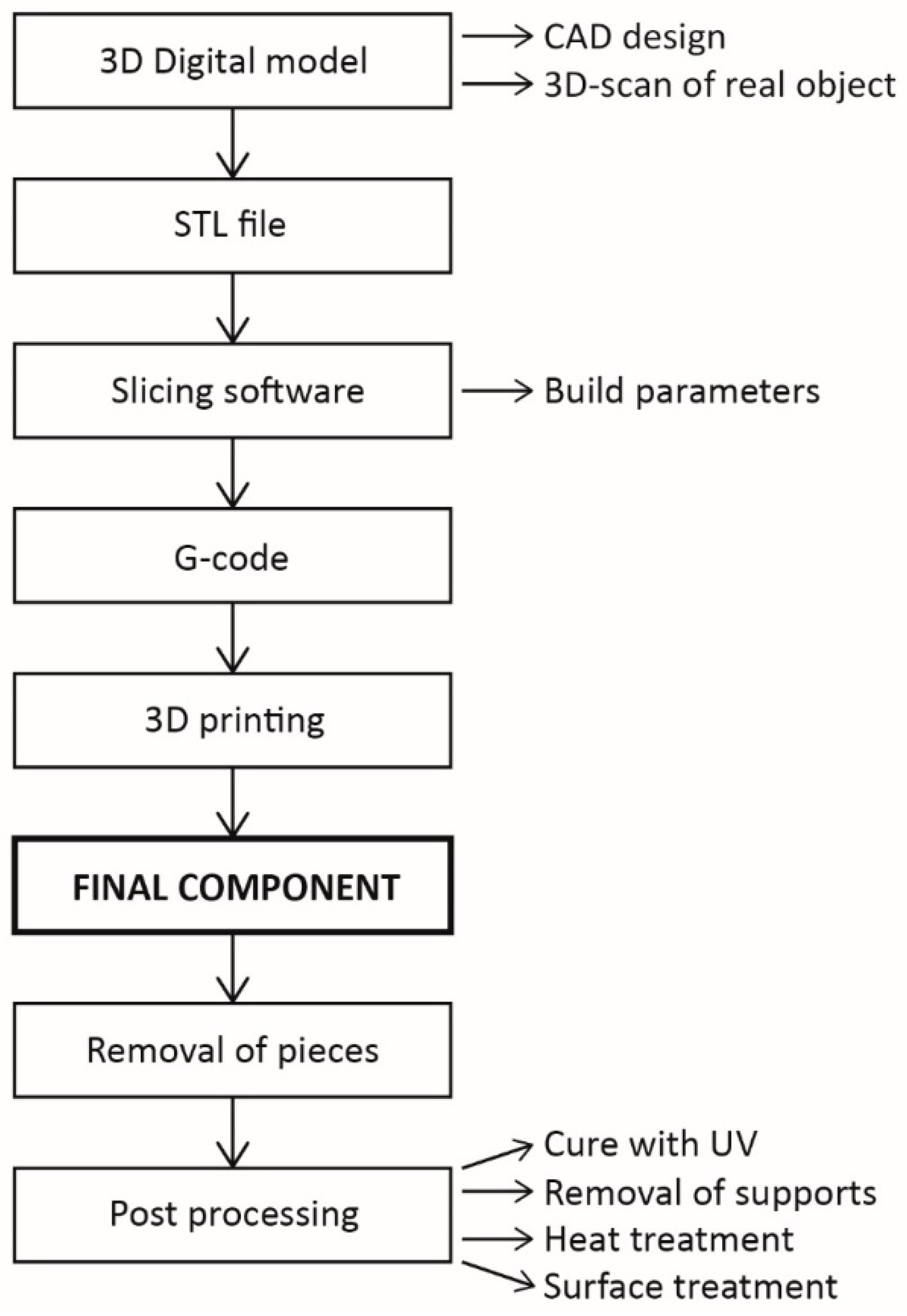
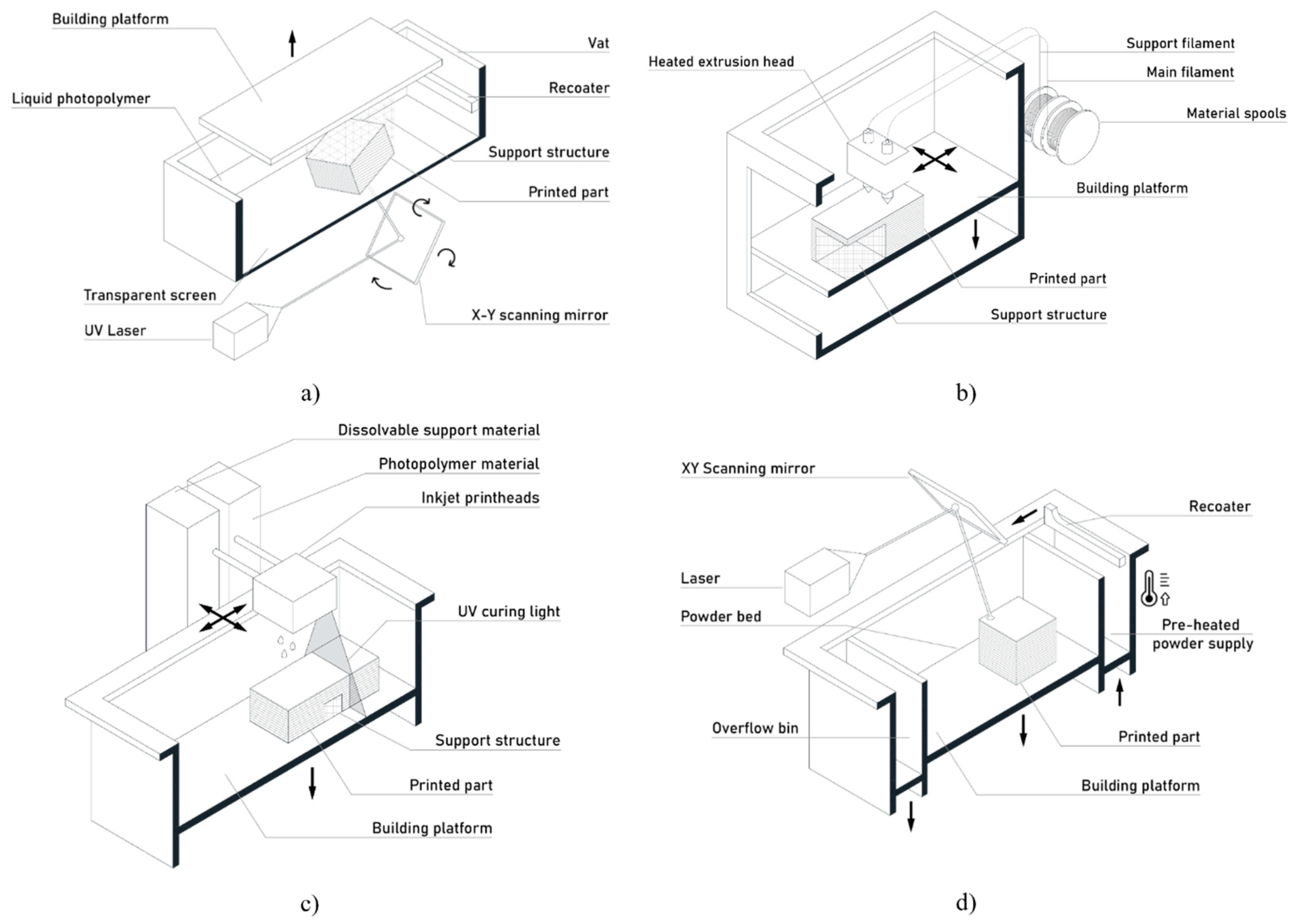

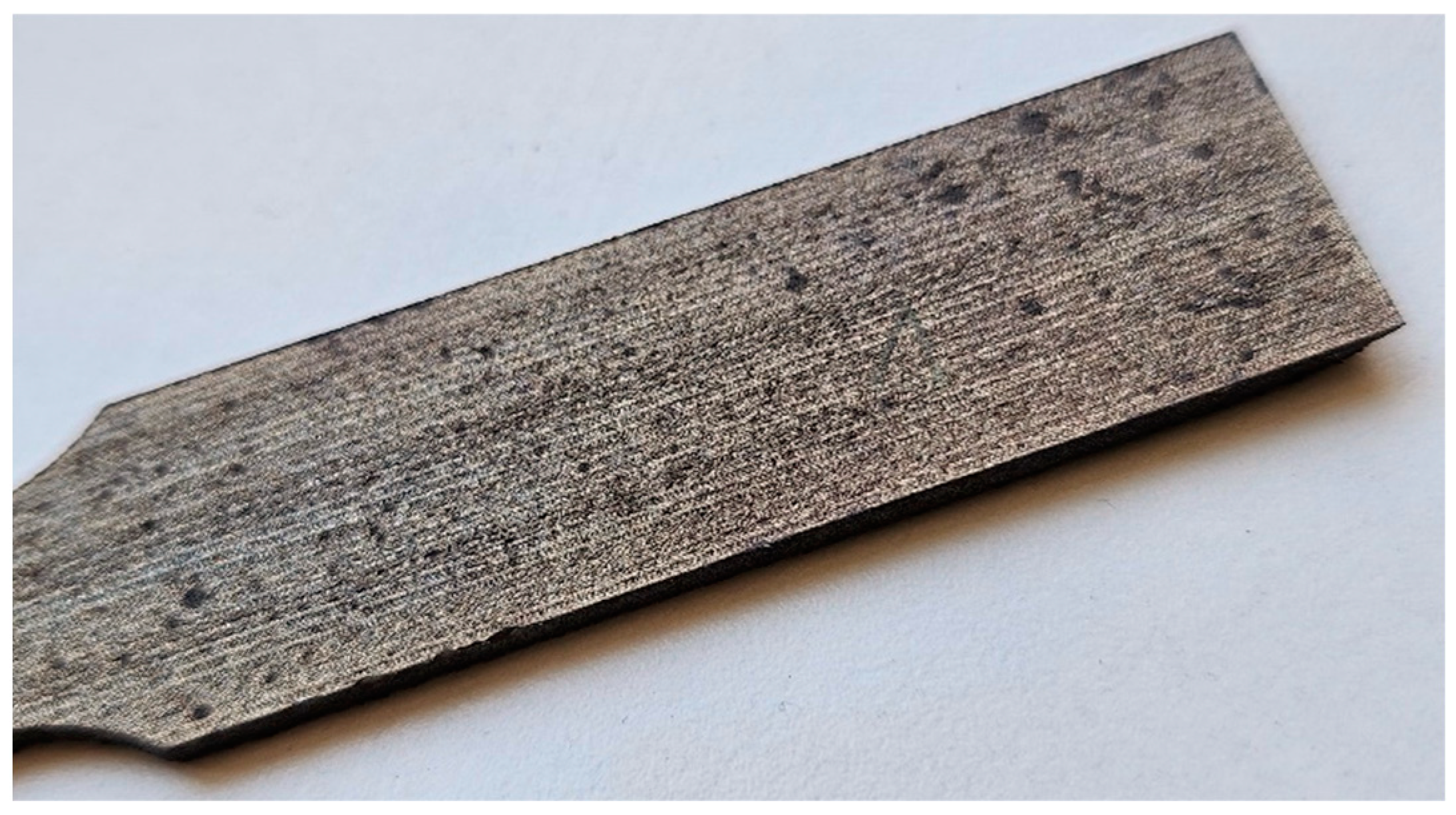
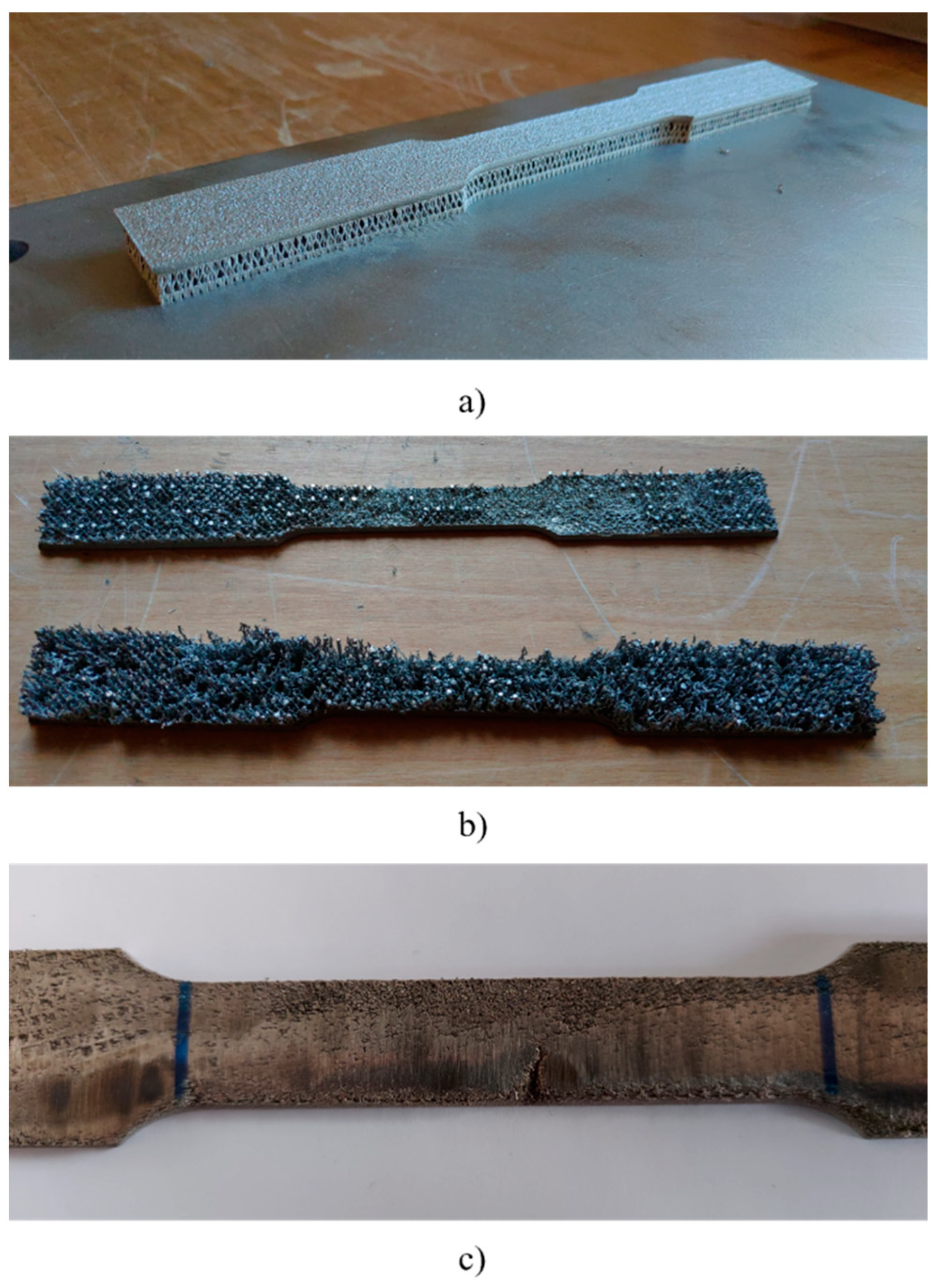

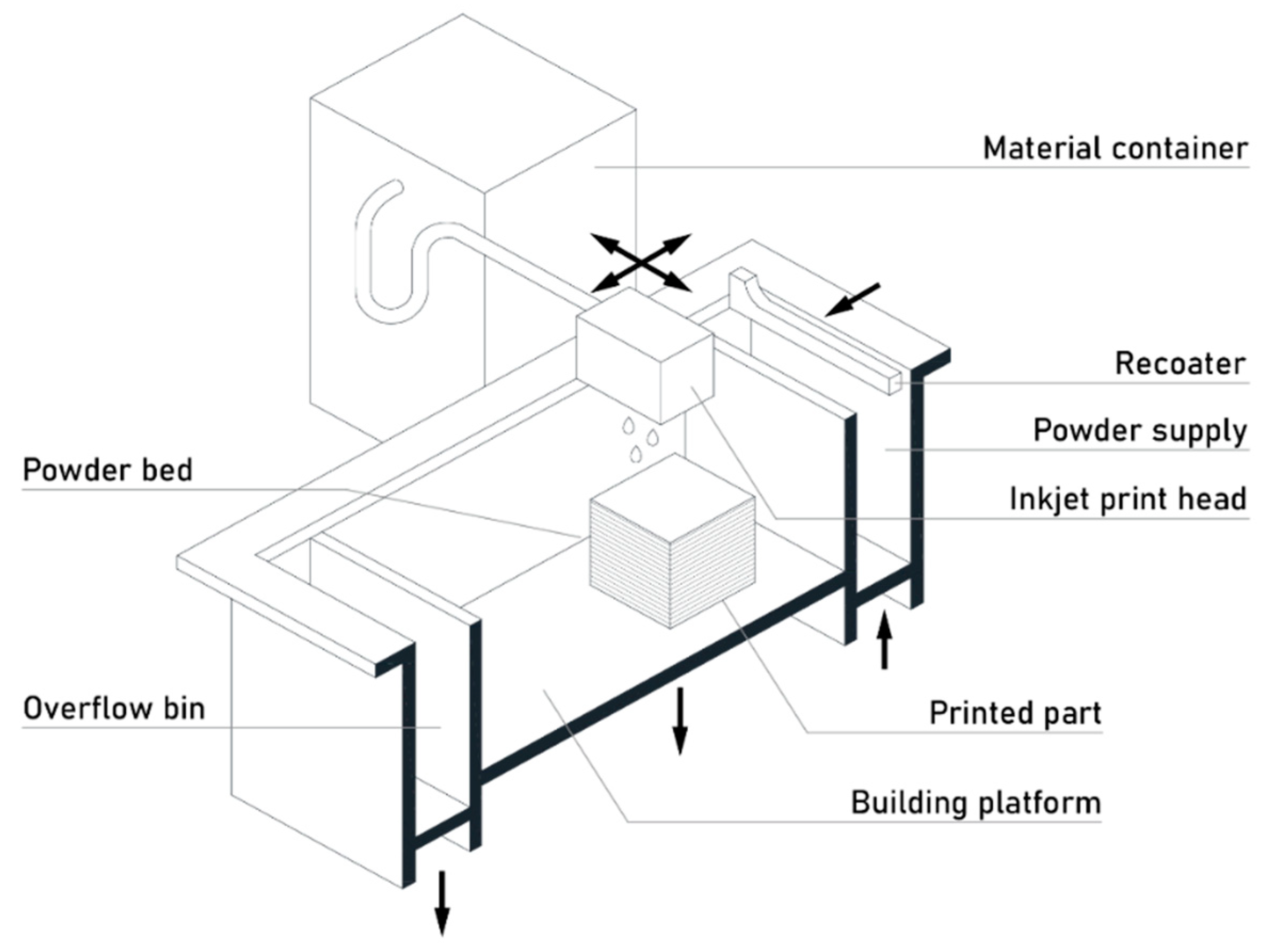
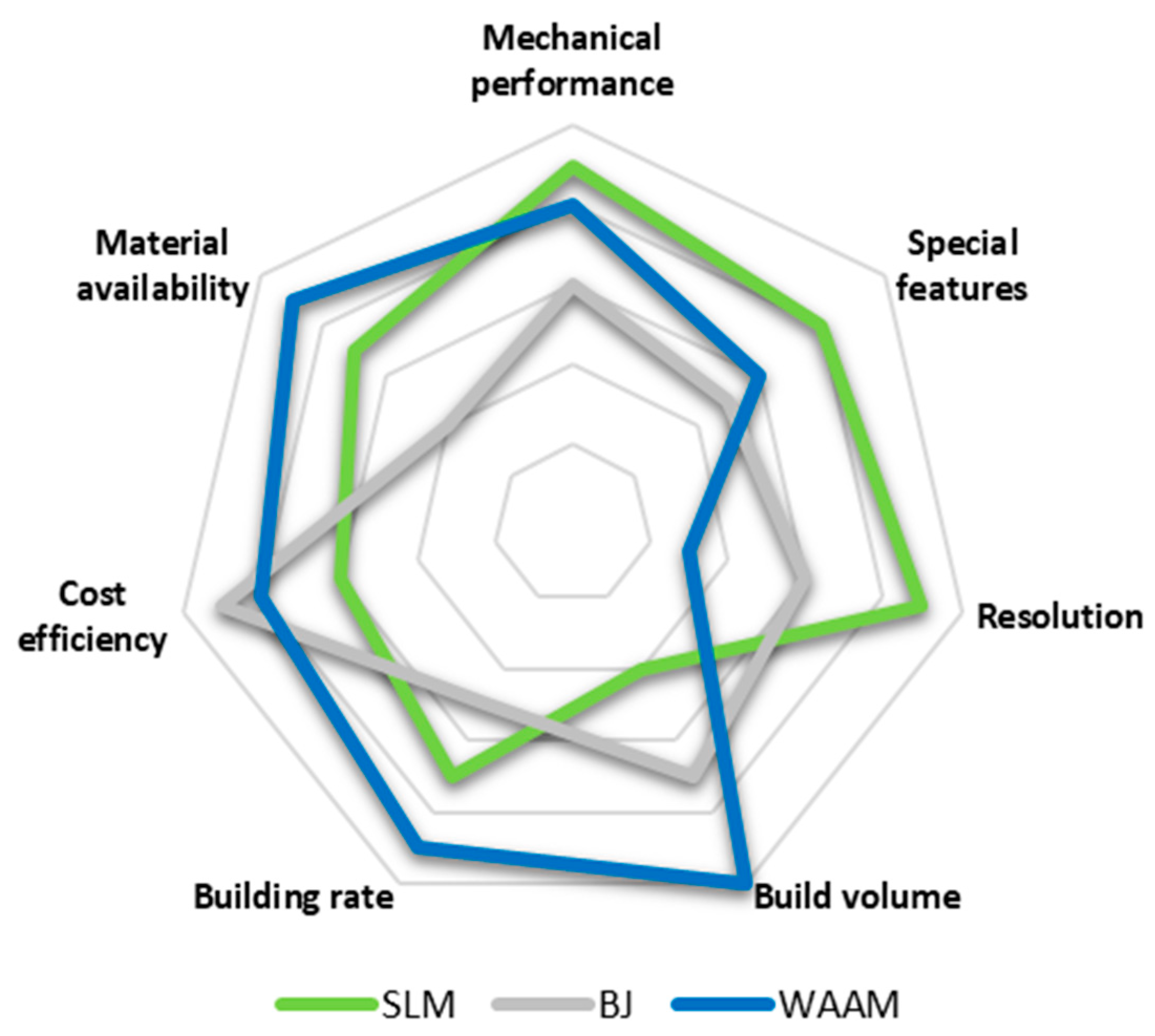
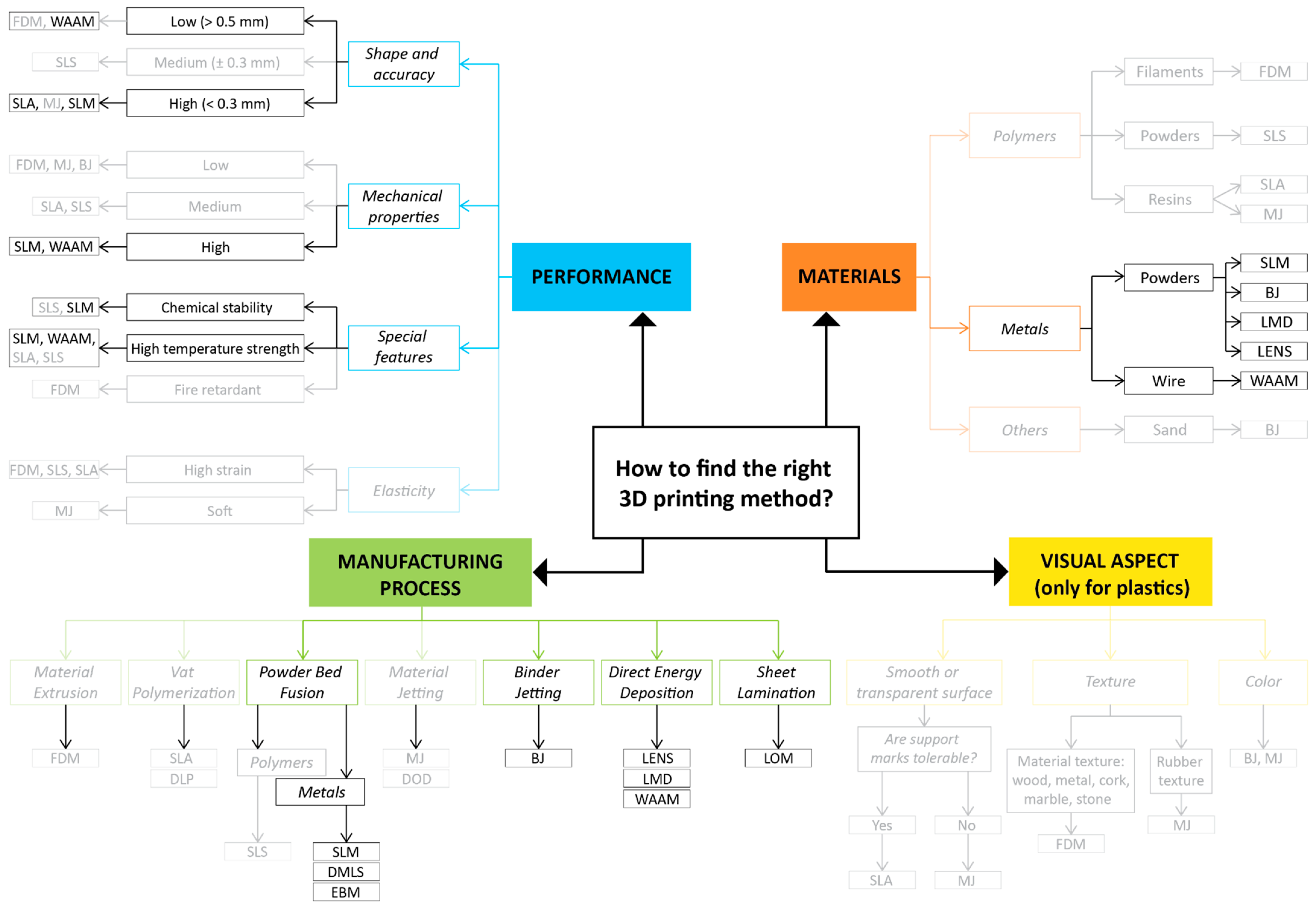
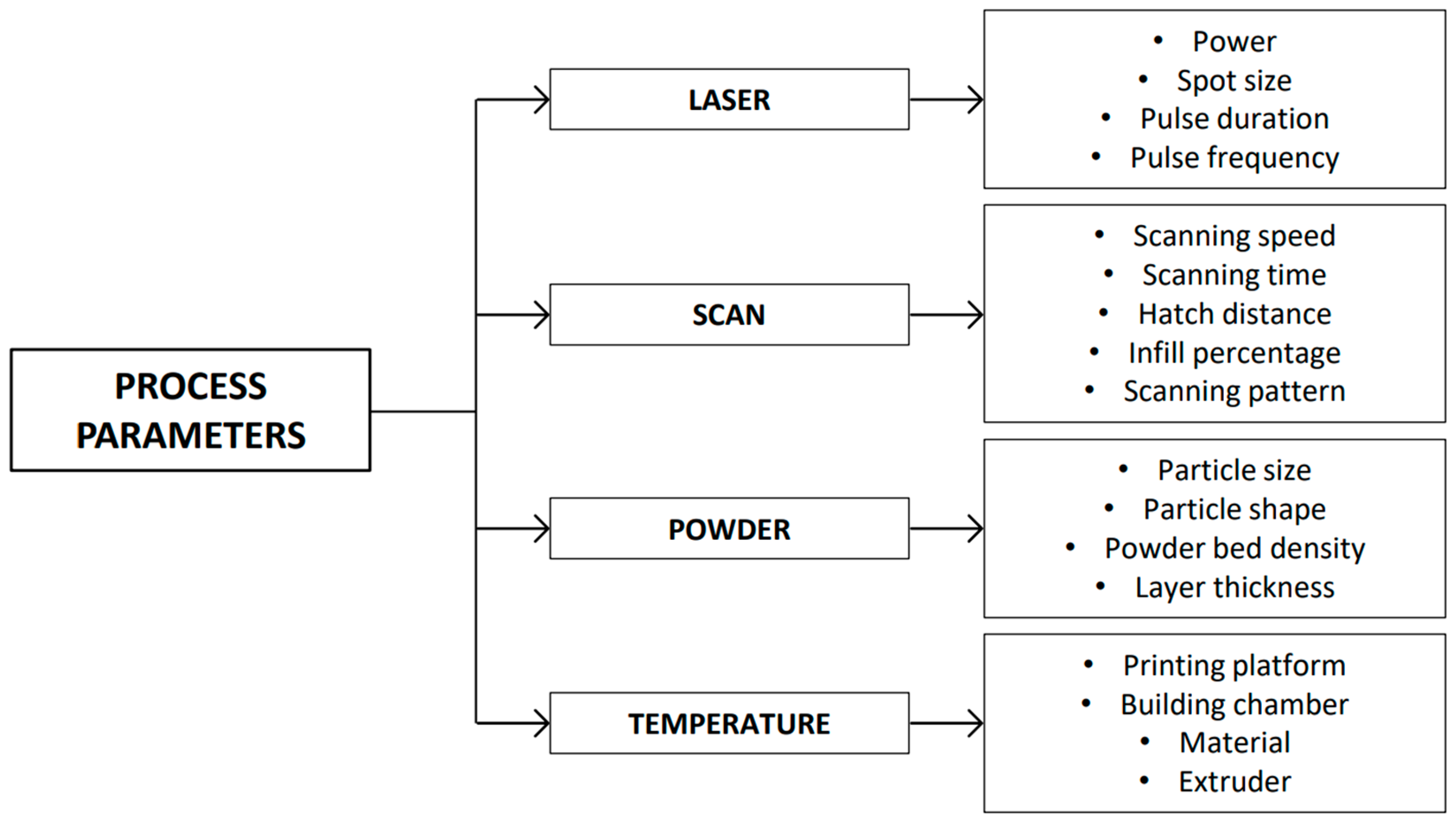
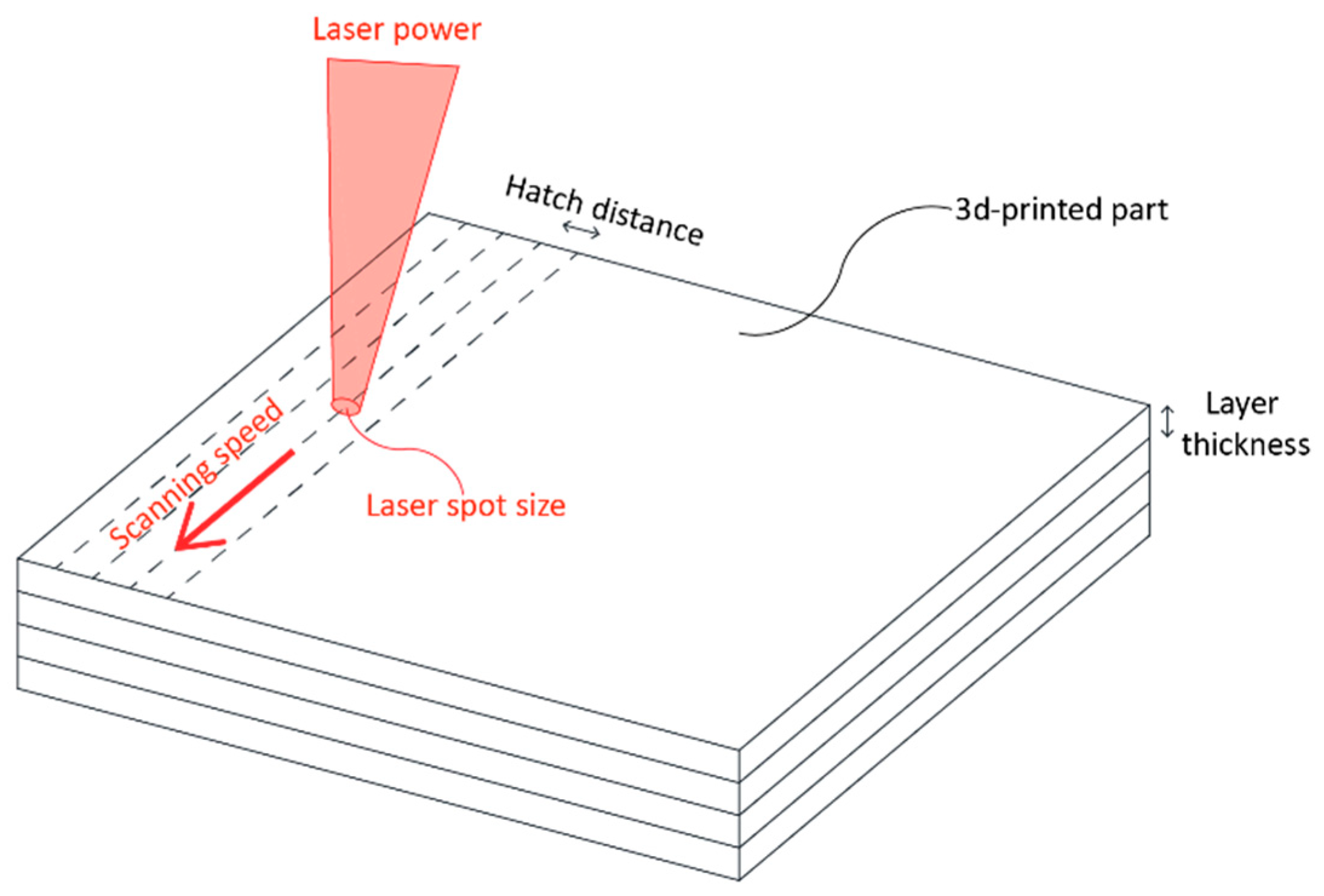
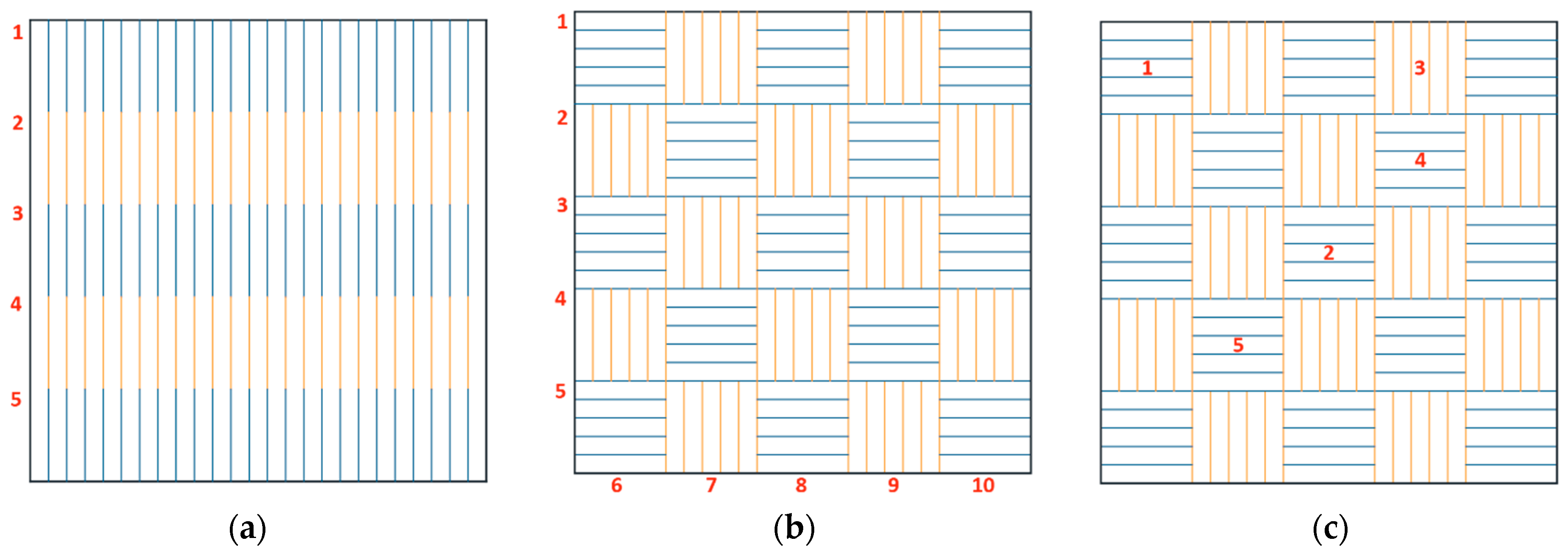


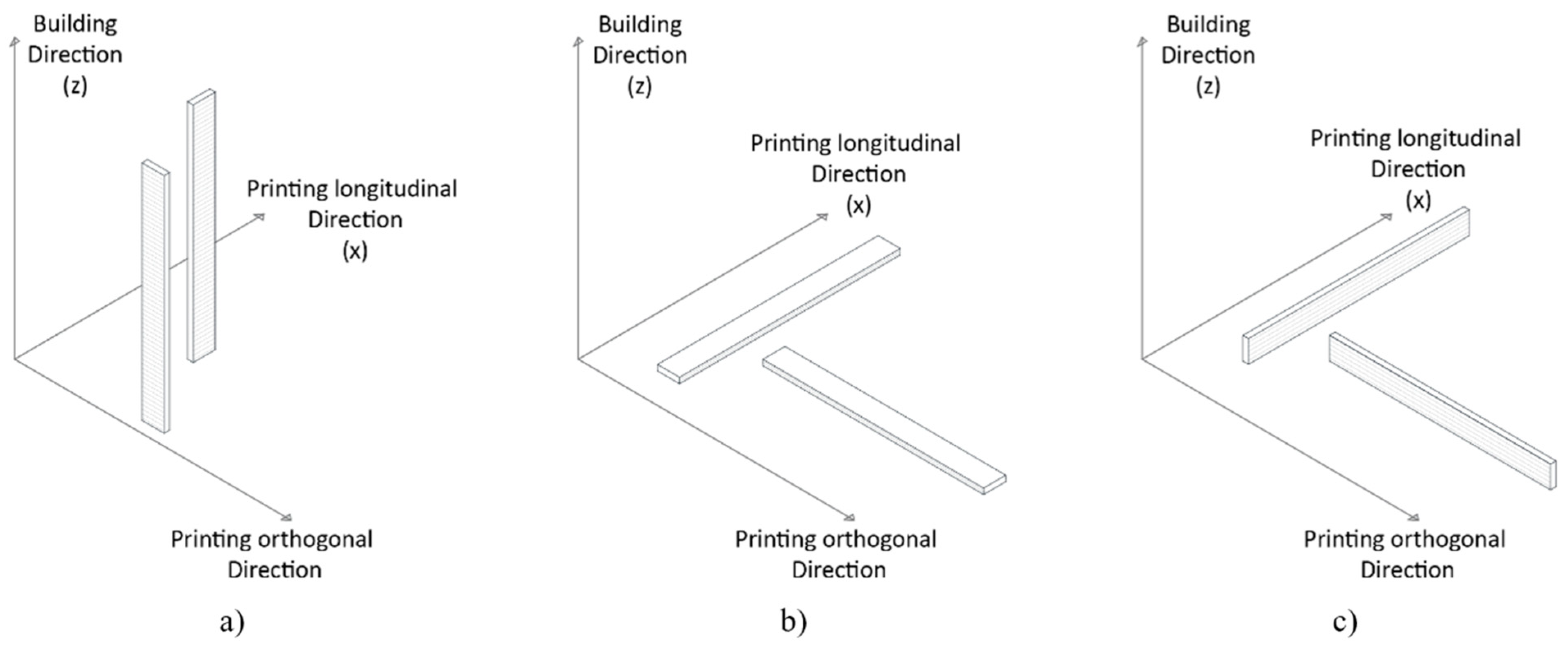
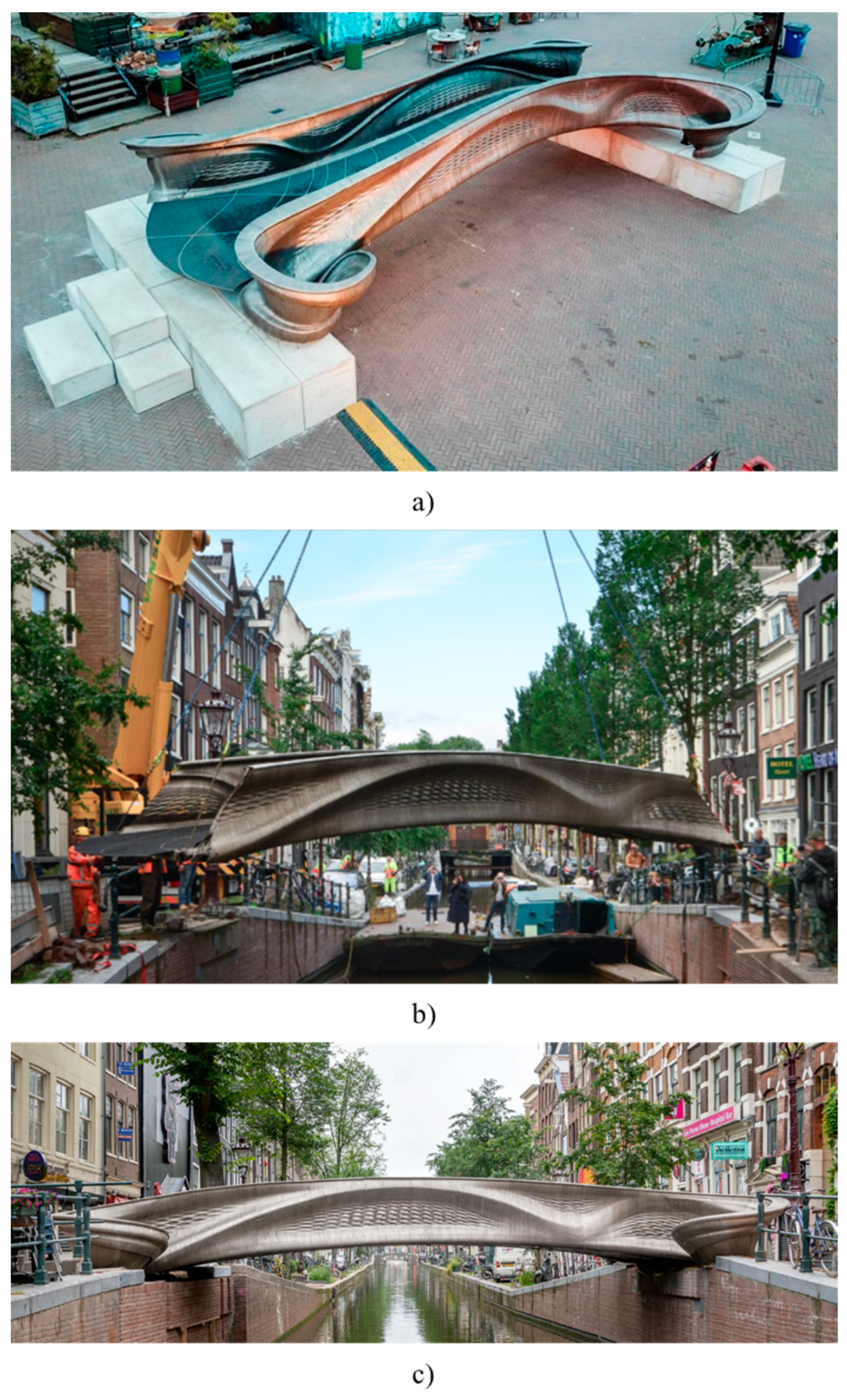

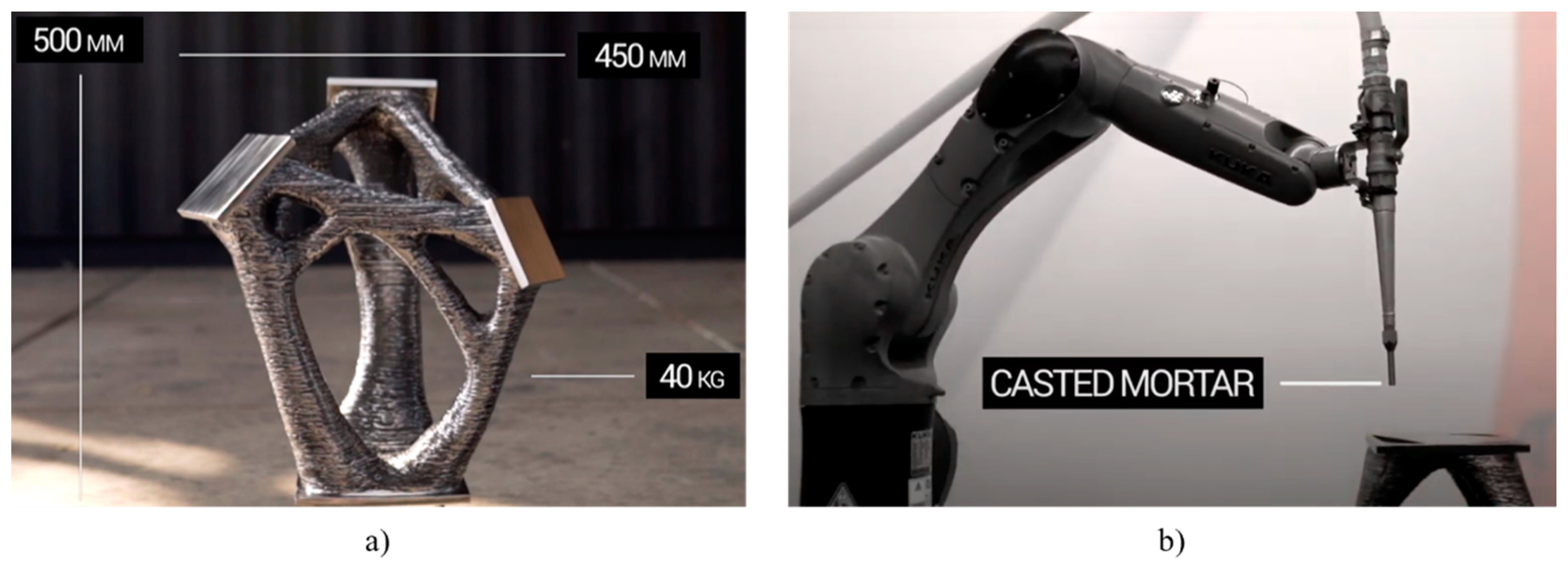


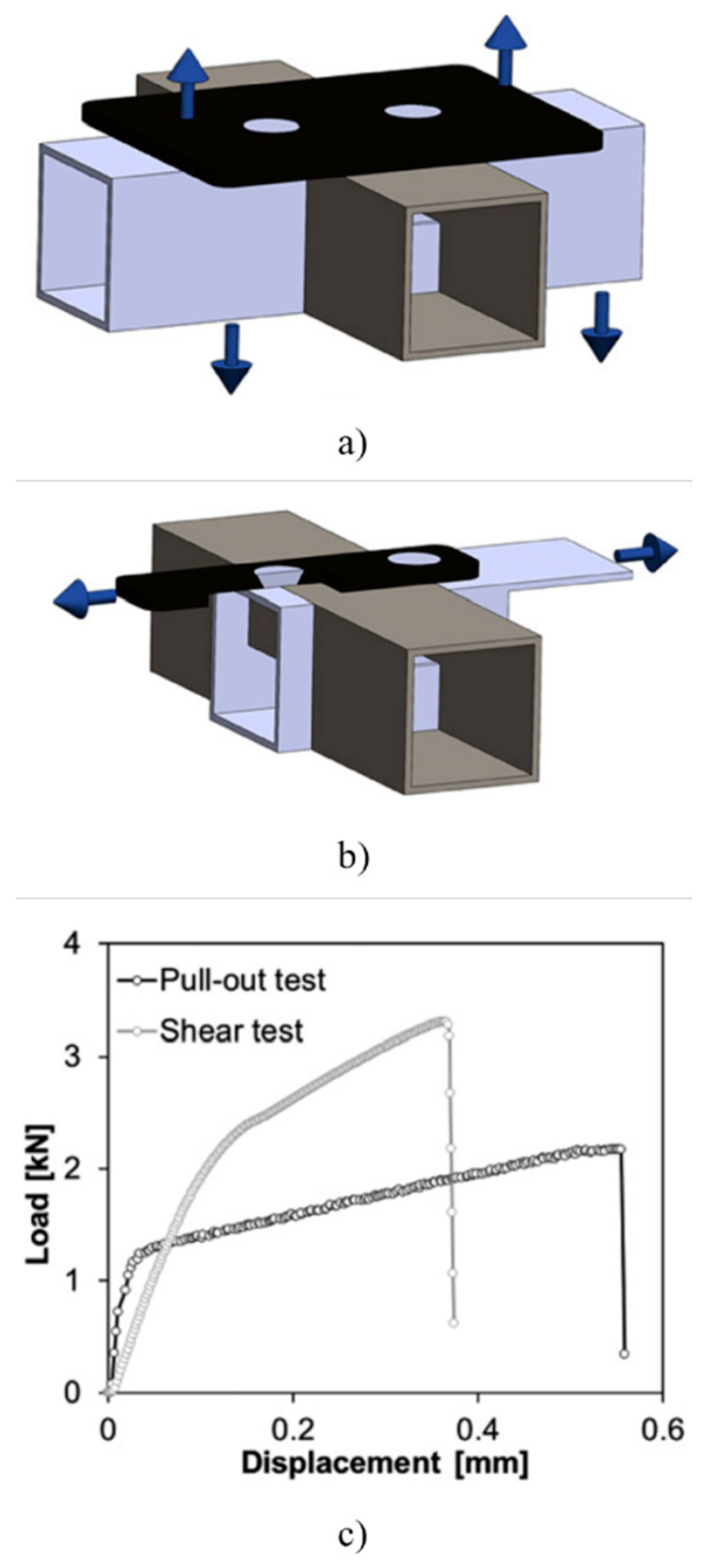
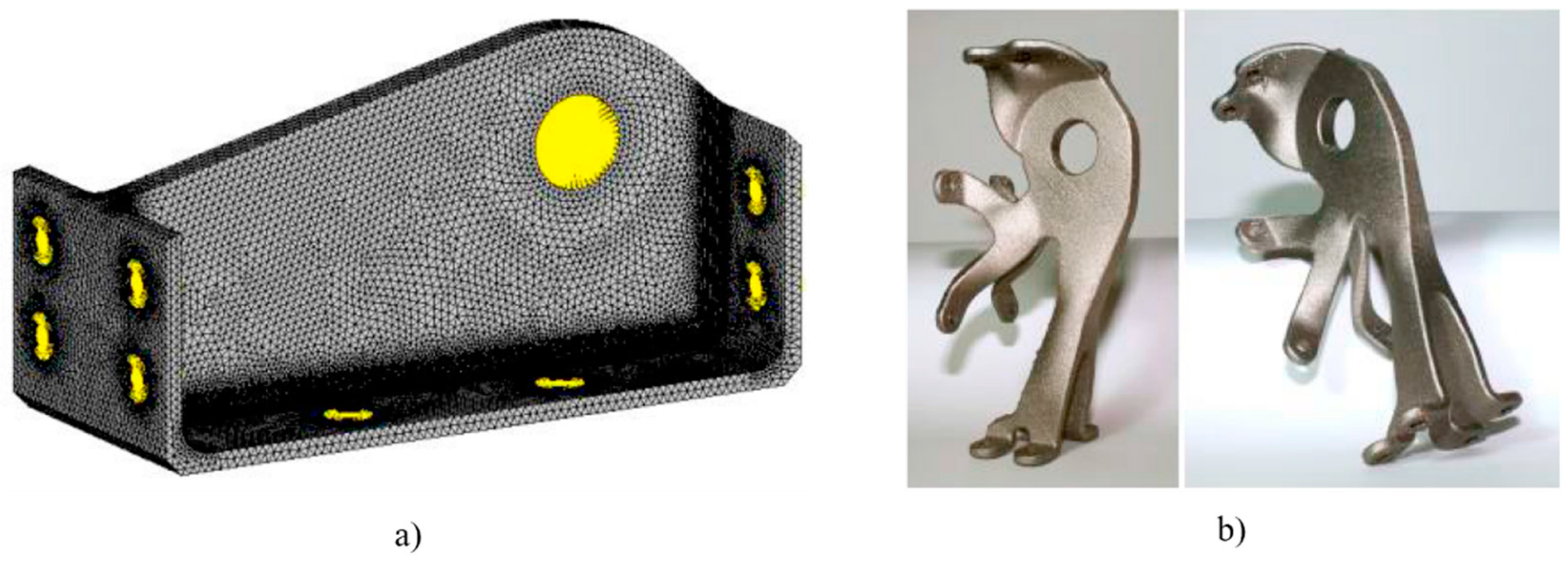





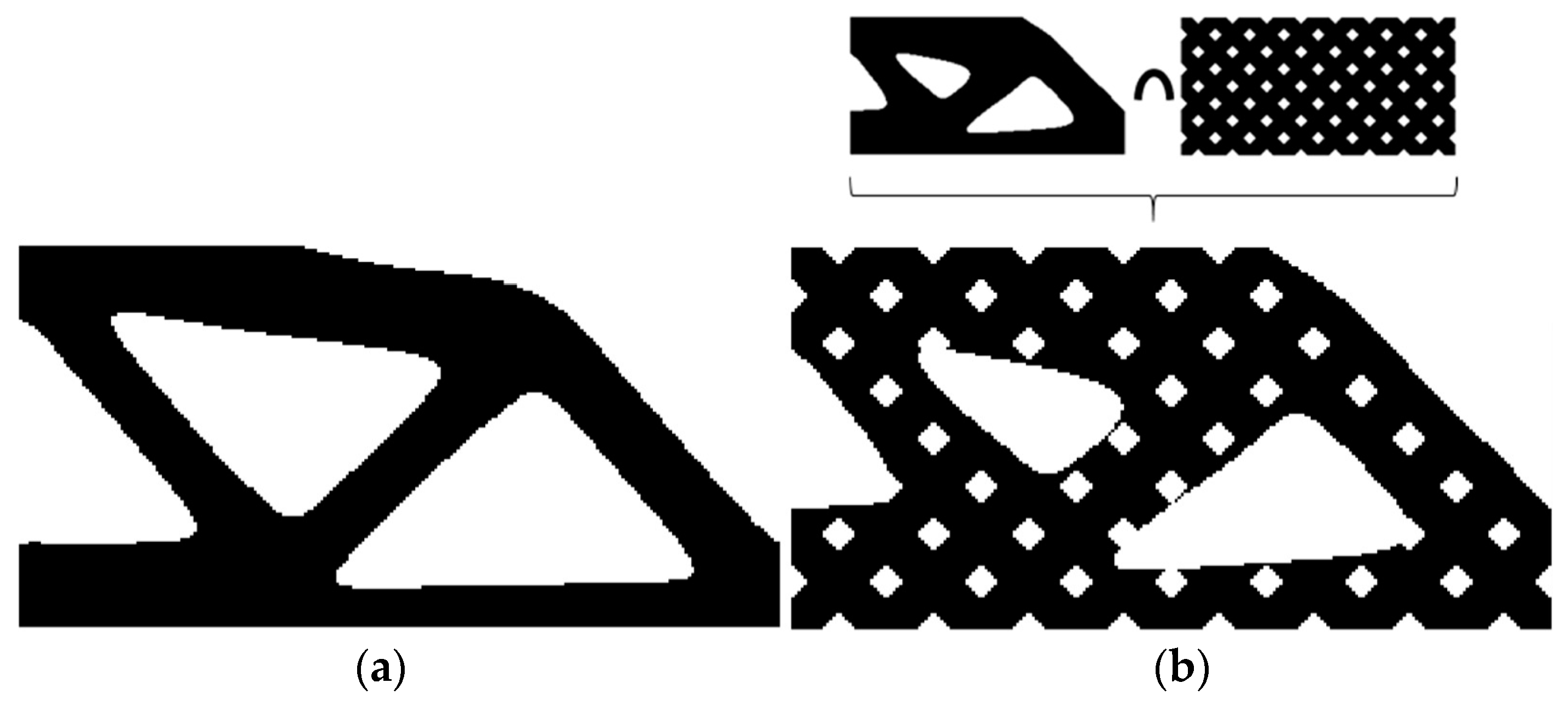

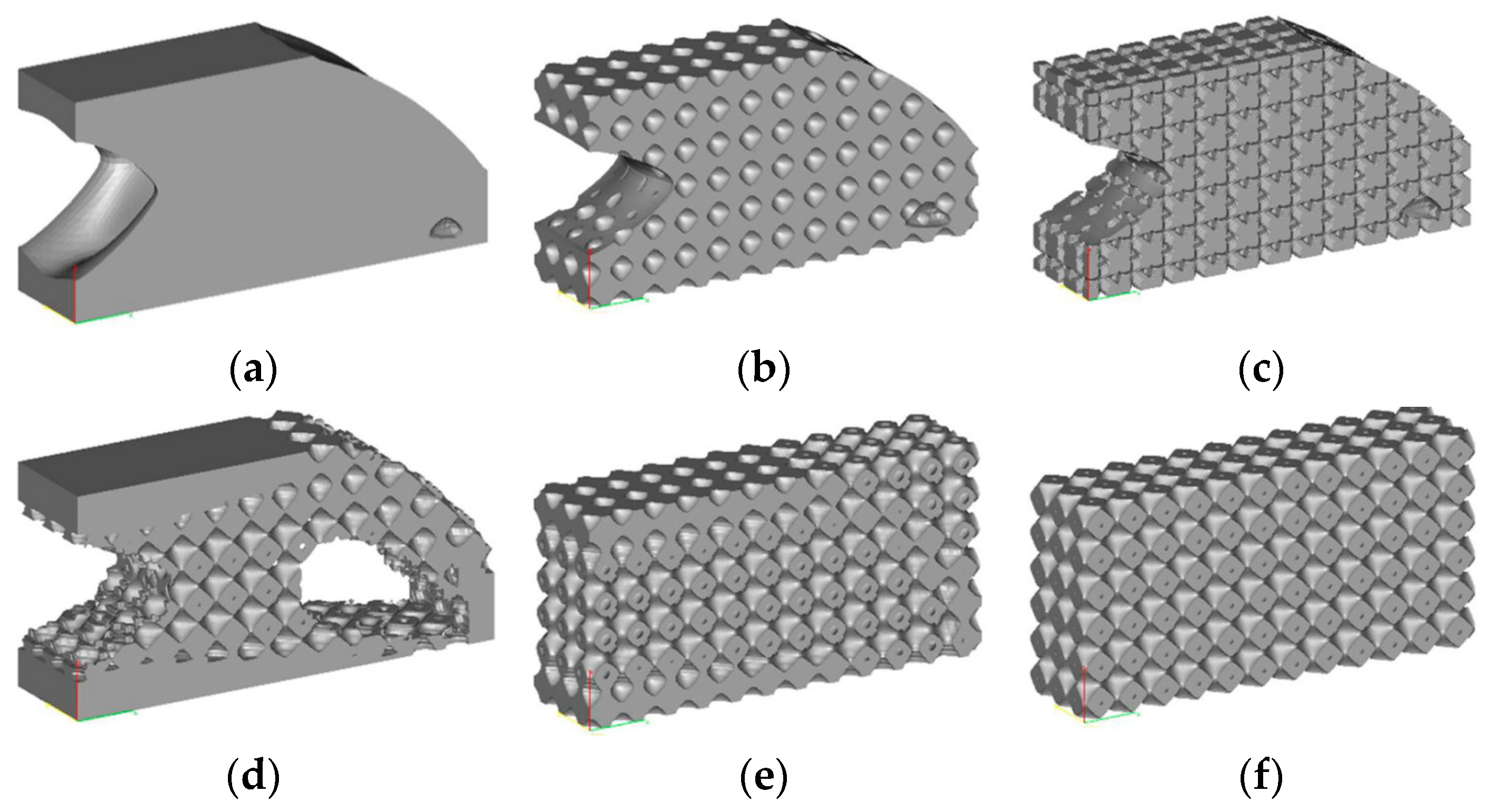
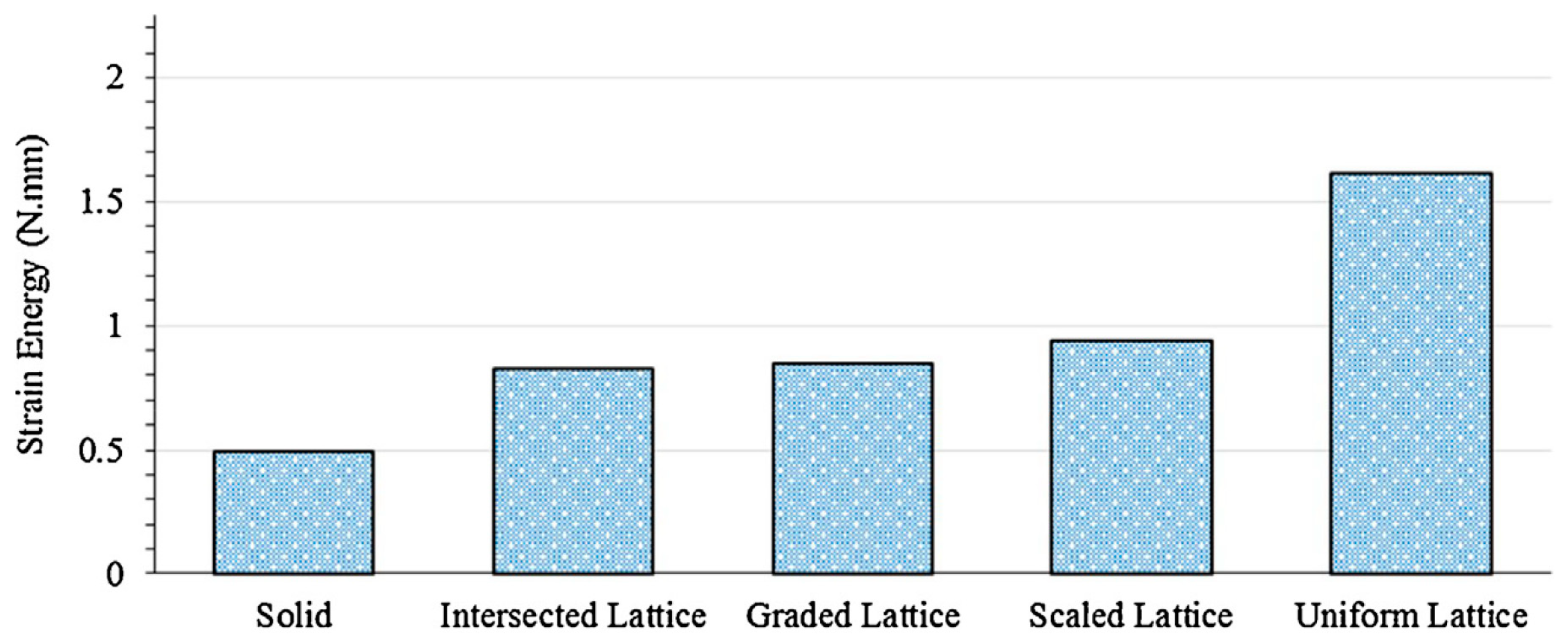
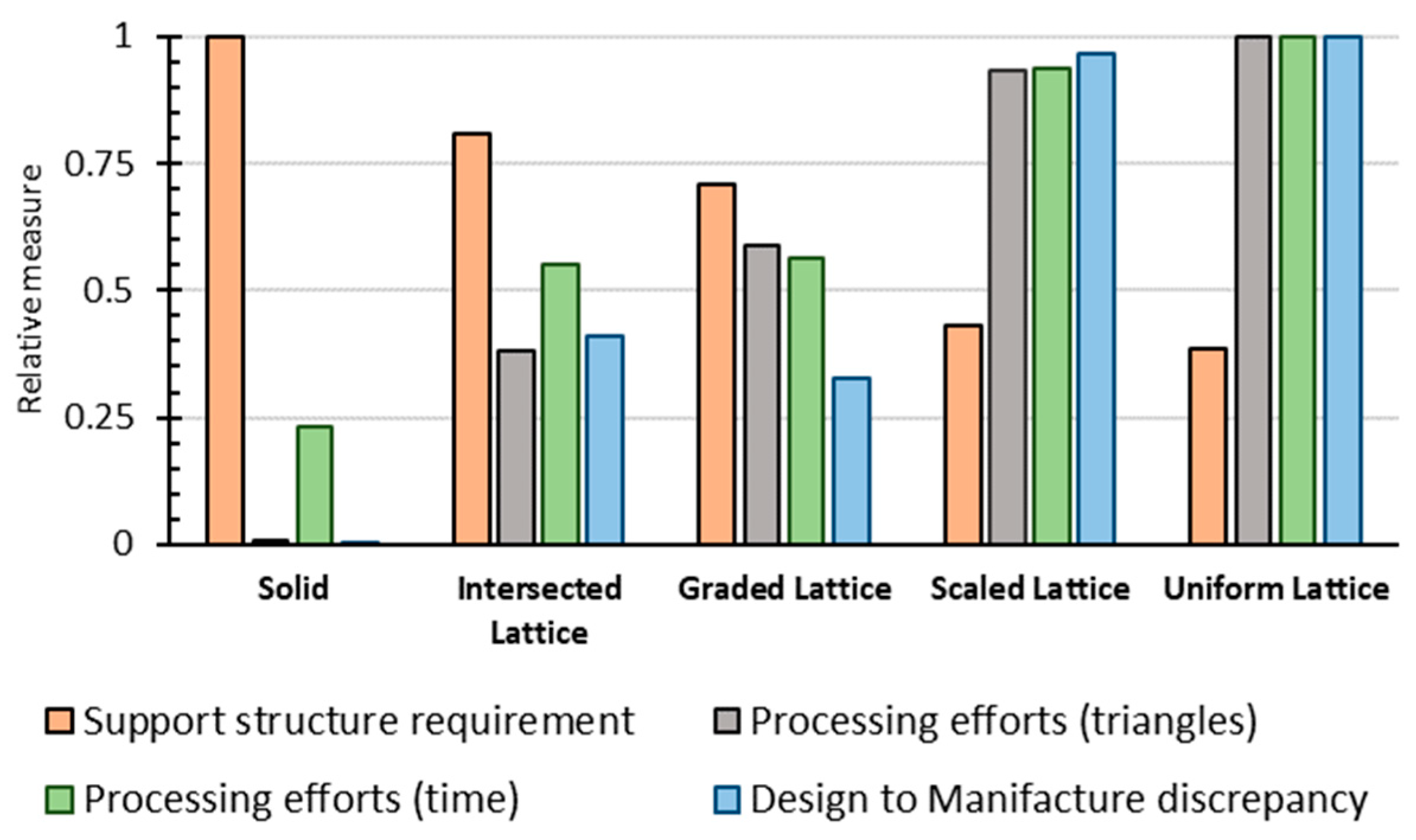
| 3D Printing Technique | Advantages | Disadvantages |
|---|---|---|
| SLM-EBM-DMLS |
|
|
| BJ |
|
|
| WAAM |
|
|
| Solid Based | Powder Based | |||
|---|---|---|---|---|
| Technology | WAAM | SLM-DMLS | EBM | BJ |
| Working Principles | Material extrusion + welding | Melting | Melting | Binding |
| Source | Electric arc | Laser beam | Electron beam | Bonding agent |
| Material Group | Metal wires | Metal powders | Metal powders | Metal powders |
| Main Available Materials | Titanium Steel Nickel Aluminium (or any weldable metal) | Stainless steel Aluminium alloys Titanium alloys Nickel alloys | Stainless steel Titanium alloys Nickel alloys Cobalt chrome | Stainless steel Bronze |
| Supports Requirement | No | Yes | Yes | No |
| Build Volume | Unlimited build volume | From 100 × 100 × 100 mm3 (small sizes) to 800 × 500 × 400 mm3 (large sizes) | 350 × 350 × 450 mm3 | Up to 800 × 500 × 400 mm3 |
| Resolution | 1 mm | 0.1 mm | 0.1 mm | 0.2 mm |
| Roughness | 50–250 µm | 10–50 µm | 15–75 µm | variable |
| Layer Thickness | min 1–2 mm | 30–50 µm | 30–50 µm | 100 µm |
| Applications | Aerospace, energy sector, research and development, cladding and repair components | Medical and dental industry, aerospace and automotive sectors | Realistic models, coloured components, casting models with complex shapes | |
Disclaimer/Publisher’s Note: The statements, opinions and data contained in all publications are solely those of the individual author(s) and contributor(s) and not of MDPI and/or the editor(s). MDPI and/or the editor(s) disclaim responsibility for any injury to people or property resulting from any ideas, methods, instructions or products referred to in the content. |
© 2024 by the authors. Licensee MDPI, Basel, Switzerland. This article is an open access article distributed under the terms and conditions of the Creative Commons Attribution (CC BY) license (https://creativecommons.org/licenses/by/4.0/).
Share and Cite
Capasso, I.; Andreacola, F.R.; Brando, G. Additive Manufacturing of Metal Materials for Construction Engineering: An Overview on Technologies and Applications. Metals 2024, 14, 1033. https://doi.org/10.3390/met14091033
Capasso I, Andreacola FR, Brando G. Additive Manufacturing of Metal Materials for Construction Engineering: An Overview on Technologies and Applications. Metals. 2024; 14(9):1033. https://doi.org/10.3390/met14091033
Chicago/Turabian StyleCapasso, Ilaria, Francesca Romana Andreacola, and Giuseppe Brando. 2024. "Additive Manufacturing of Metal Materials for Construction Engineering: An Overview on Technologies and Applications" Metals 14, no. 9: 1033. https://doi.org/10.3390/met14091033








